Abbey Banner
Spring 2023

do not reduce in size (size or place between 100% and greater) use alternative logo for smaller size
15:3

“Great and wonderful are your works, Lord God Almighty!”
Pauley, O.S.B.
Revelation
John-Bede
Abbey Banner
Magazine of Saint John’s Abbey
Spring 2023 Volume 23, Number 1
Published three times annually (spring, fall, winter) by the monks of Saint John’s Abbey.
Editor: Robin Pierzina, O.S.B.
Design: Alan Reed, O.S.B.
Editorial assistants: Gloria Hardy; Patsy Jones, Obl.S.B.; Aaron Raverty, O.S.B.
Abbey archivist: David Klingeman, O.S.B. University archivists: Peggy Roske, Elizabeth Knuth
Circulation: Ruth Athmann, Tanya Boettcher, Debra Bohlman, Chantel Braegelmann
Printed by Palmer Printing
Copyright © 2023 by Order of Saint Benedict, Collegeville, Minnesota.
ISSN: 2330-6181 (print)
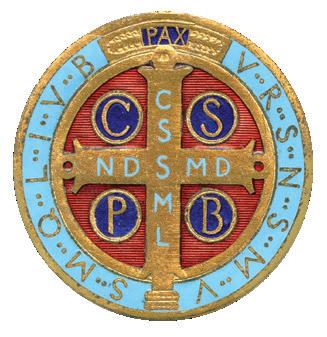
ISSN: 2332-2489 (online)
Saint John’s Abbey 2900 Abbey Plaza Box 2015 Collegeville, Minnesota 56321–2015 saintjohnsabbey.org/abbey-banner
Change of address: Ruth Athmann P. O. Box 7222 Collegeville, Minnesota 56321–7222 rathmann@csbsju.edu Phone: 800.635.7303
Subscription requests or questions: abbeybanner@csbsju.edu
“Remember what he said to you . . . that the Son of Man must be handed over to sinners and be crucified, and rise on the third day.” The women . . . told this to the apostles, but their story seemed like nonsense, and they did not believe them.
Luke 24:6–7, 9–10
This issue ponders the Paschal mystery, the heart of our Christian faith. From Calvary to the tomb, from Good Friday to Easter morning, the Gospel accounts of Jesus’ passion, death, and resurrection are filled with drama and emotion—of betrayal, abandonment, sorrow, bewilderment, amazement, terror, and joy. Abbot John Klassen reflects on Matthew’s use of earthquakes to frame the passion and resurrection narrative. All four Gospels agree that following the death of Jesus, Joseph of Arimathea prepared Jesus’ body for burial. Father Cyprian Weaver outlines the research, studies, and opposing views regarding what became of Jesus’ burial garment as he introduces the Shroud of Turin. Dr. Martin Connell presents three artistic interpretations, three theologies of what happened between Jesus’ death and his resurrection. The African-American spiritual asks: Were you there when they crucified my Lord? Father Kilian McDonnell shares poetic reflections on the women at the cross and the women at the tomb.
Mark’s Gospel ends with the divine command: “Go into the whole world and proclaim the gospel to every creature” (Mark 16:15). For twenty years, members of the Saint John’s Abbey Benedictine Volunteer Corps have given witness to the good news through their service to the needy around the world—service that has been richly rewarded. Mr. Joseph Stangler tells of his service in Puerto Rico and of the transformative experience of learning from adversity. Mr. Joseph Luedke shares “one of the greatest epiphanies of my life”: seeing the suffering of the poor blossom into joy through the creativity of their artistic expression.
“In the popular imagination, monks are retiring figures,” observes Brother Aaron Raverty, as he introduces us to the Weber brothers—Fathers Arnold and Otto—whose vigor and passion for service and ministry shattered that stereotype.
Did you know there are shrimp in the abbey arboretum? Abbey land manager Mr. John Geissler presents a few of the critters—frogs, salamanders, and even freshwater shrimp—that inhabit the vernal pools of the arboretum. We also learn how abbots are elected, how to make a fabulous pie crust, meet a monk who is a terrible dinner partner, and more.
For the past five years, Dr. Martin Connell has shared a theological reflection on works of art at Saint John’s. We acknowledge, with deep gratitude, Martin’s contributions to Abbey Banner as he concludes his service.
Cover: Rural scene by Juma, Nairobi, Kenya
Photo: Benedictine Volunteer Corps archives
Along with Abbot John and the monastic community, the Abbey Banner staff extends best wishes and prayers for God’s blessings throughout the Easter season. Peace!
Brother Robin Pierzina, O.S.B.
Abbot John Klassen, O.S.B.

Earthquakes strike fear in human communities—and for good reason. The recent earthquake of 7.8 on the Richter scale in Syria and Turkey killed 57,000 people, injured another 119,000, destroyed 200,000 buildings and damaged millions more, and did an estimated 75 billion dollars in damage.
The evangelist Matthew frames the key events of his passion and resurrection narrative with two earthquakes. But here the earthquake has a different purpose. While the recent earthquake and its aftershocks have been hugely destructive, Matthew intends the earthquake to be a sign of God’s life-giving, saving power: “Jesus cried out again in a loud voice, and gave up his spirit. And behold, the veil of the sanctuary was torn in two from top to bottom. The earth quaked, rocks were split, and tombs opened up” (Matthew 27:50–52). Just as tombs are opened and holy ones are released from death, so we are released from our sins.
Matthew’s resurrection account opens with these words: “And behold there was a great earthquake; for an angel of the Lord descended from heaven, approached, and rolled back the stone, and sat on it” (Matthew 28:2). Though this earthquake is not of a large magnitude, Matthew is indicating in the clearest possible terms that both the cross and resurrection of Jesus are of cosmic significance. Christ’s hewn tomb, his burial chamber—where death seems to have the last word— is opened by God’s singular power, and it becomes the womb of the New Creation. The angel uses that huge stone as its throne.
“Earthquake” moments do come to us in our lives. We have moments of clarity in our faith, for example, where we are driven to our knees, aware of how incredibly fragile and vulnerable we are and that we are truly in God’s hands. At other times, we discover the love of another person or community, and we know that, no matter what else happens, we want to live our lives with that person or community. Sometimes the earth quakes when we discover our gifts, what we should do with our lives, how we should spend our time and energy. We no longer have mere options; we know what we must do. Or we may be puzzled by the situation in this country, by the racism or sexism, the homophobia that hurts so many people. But through study, reading, thinking, listening, and praying, we discover what energizes and sustains these modes of harming so many people. And we know how we must change.
Spring 2023 Abbey Banner 4 5 This Issue
Abbey archives
Earthquake Moments
The cross and resurrection of Jesus are of cosmic significance.
The Shroud of Turin
Cyprian Weaver, O.S.B.
The Gospel accounts of the Passion agree that following the death of Jesus, Joseph of Arimathea prepared Jesus’ body for burial. “Having bought a linen cloth, he took [Jesus] down, wrapped him in the linen cloth and laid him in a tomb” (Mark 15:46; see also Matthew 27:59; Luke 23:53; John 19:38–40). Three days later, Jesus would conquer death and rise from the tomb. But what became of that “linen cloth” used for his burial? One theory suggests that members of the early Church in Jerusalem preserved the cloth and that, over the centuries, it was transported to Europe, eventually finding a home in northern Italy where it became known as the Shroud of Turin.
Is the Shroud of Turin really the cloth that wrapped the crucified body of Jesus, or is it a medieval hoax? The terminally pious are satisfied that the shroud is genuine. Others are more skeptical. Numerous scientific studies have provided an enormous volume of research data that may fall short of a definitive answer—but equally, the research provides evidence that even skeptics are challenged to refute. The shroud remains an unsolved mystery.
Mediterranean Journey
During the first century A.D., many followers of Christ fled from Jerusalem when hostilities broke out between Jewish

Zealots and the Roman rulers, migrating to Antioch in Syria (Acts 11:19). Antioch was the third largest city, after Rome and Alexandria, in the Roman Empire. In the fourth century, Athanasius I of Alexandria recalled the flight of Christians at the earlier time and, in a sermon, suggested that in A.D. 86, an image of Jesus at full length was taken from Jerusalem to Syria.
In the thirteenth century, French knight Crusader Robert de Cléry wrote (in De la Conquête de Constantinople [On the Conquest of Constantinople]) a detailed account of the conquest of the Greek city of Edessa, including a reference to the shroud: “[at] the Church of my Lady Saint Mary of Blachernae, within which was the shroud wherein our Lord was wrapped . . . . And none knows—
neither Greek nor Frank—what became of that shroud when the city was taken.”
The first undisputed appearance of the shroud was at Lirey in northern France, ca. 1355, when it was exhibited by Geoffroi I de Charny (ca. 1300–1356) and his wife Jeanne de Vergy (d. 1428). In 1389, it was denounced as fraudulent by the bishop of Troyes, who asserted that it was “cunningly painted, the truth being attested by the artist who painted it.” In 1453 Geoffroi de Charny’s granddaughter Marguerite gave the shroud to the House of Savoy at Chambéry, France, and there it was damaged by fire and water in 1532. It was moved to the Italian city of Turin in 1578 where it is preserved in the royal chapel of the cathedral of San Giovanni Battista.
Shroud Features
The Shroud of Turin—made of linen (flax) fabric, herringbone weave, 14 ’ 3 ” long and 3’ 7 ” wide—bears the image of a crucified man with abundant blood stains within the body image. The image on the shroud is much clearer in a black and white photographic negative— first observed in 1898 by photographer Secondo Pia—than in its natural sepia color.
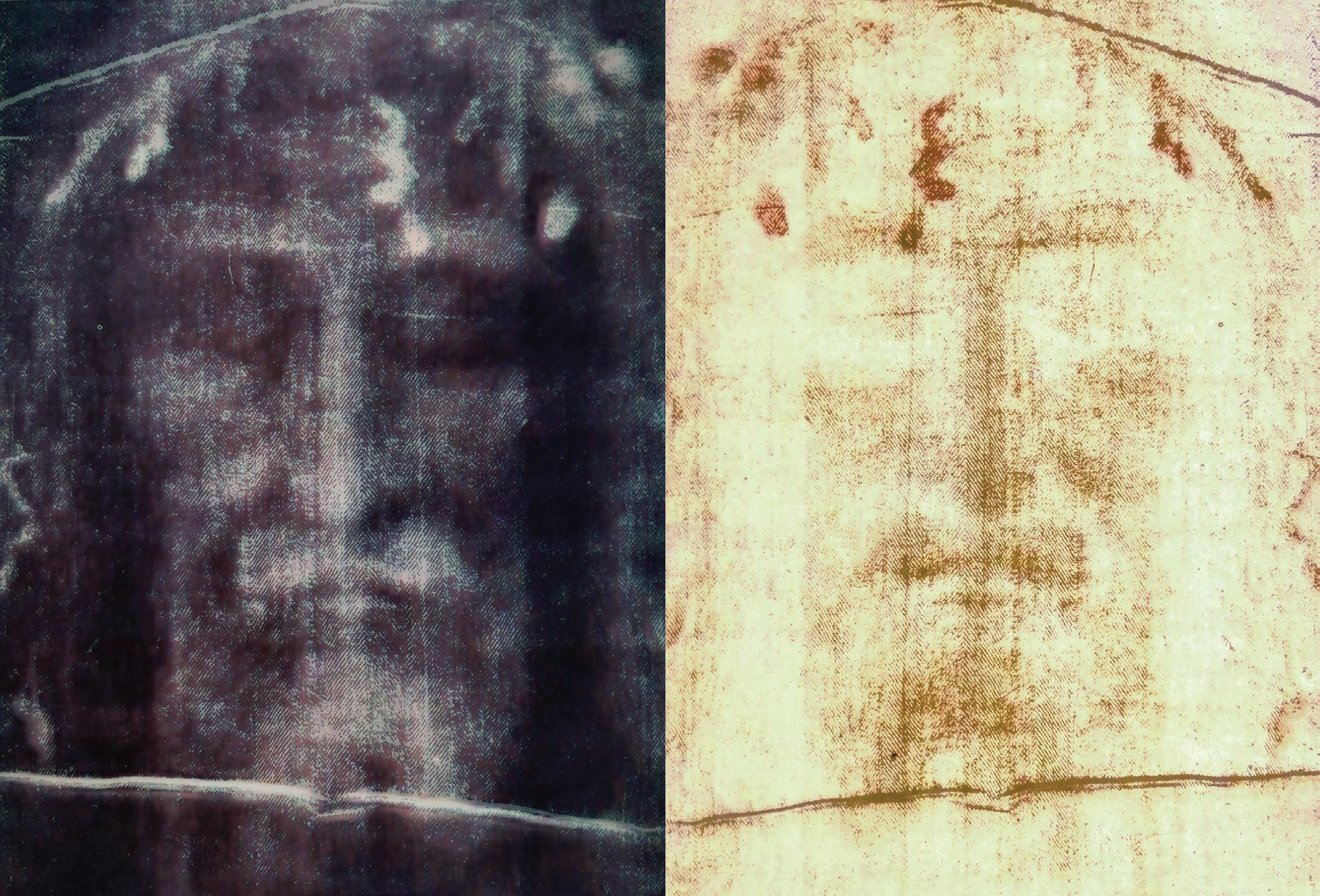
The image reveals a nude male, 5 ’ 9 ” in height, 30–40 years of age. Studies suggest that the
man had a forked beard, welldefined mustache, and shoulderlength hair, parted in the middle. There are small wounds around the forehead; the left wrist bears a large, round wound. Blood flow is apparent on head, arms, wrist, foot, and left side of thorax. A large blood stain drains from a puncture wound in the middle of the right foot. On the back, there are lacerations, as if from flogging. The calves show evidence of trauma. There is no evidence of decomposition.
The dorsal image shows puncture wounds in the scalp and
abrasions of the shoulders. There are more than one hundred scourge marks on the shroud and more than three hundred puncture wounds—all indicative of extreme trauma and traumatic injury.
Research and Studies
Modern reseach and studies related to the Shroud of Turin date to the end of the nineteenth century. In May 1898 Secondo Pia, an amateur photographer, was allowed to photograph the shroud. When he developed the plates, he was astonished to find
Spring 2023 Abbey Banner 6 7
Ondřej Žváček/Wikimedia Commons
Golgatha, Church of the Holy Sepulchre, Jerusalem
Negative and positive images from the face of the Shroud of Turin
Rudolf Berwanger/Wikimedia Commons
the reverse plate showed the image of a man and a face that could not be seen with the naked eye. In 1902 Yves Delange, professor of zoology at the Sorbonne University, who along with his assistant Paul Vignon studied photos of the shroud, concluded that “the body wrapped in the shroud was that of Jesus.” Science, he asserted, had determined that the shroud is not a painting; no pigments are involved in its imaging; the image is an imprint of a human corpse produced by the action of natural forces.
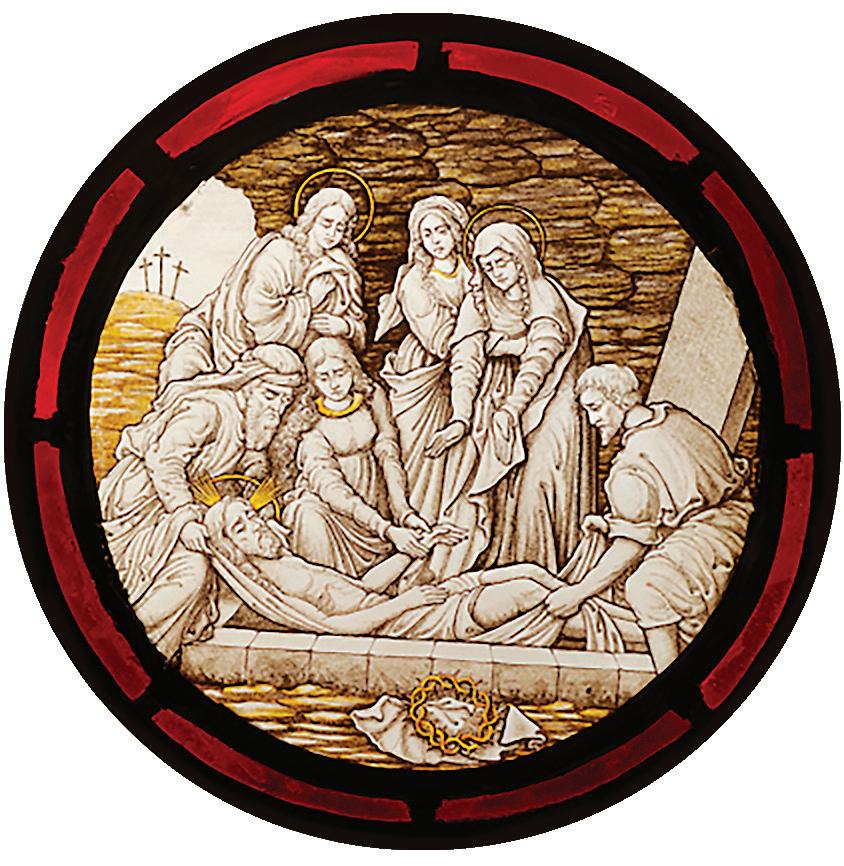
In 1973 and 1978 Max Frei, Swiss criminologist and botanical expert, studied dust samples of the shroud that contained pollen. He identified 57 pollen species in all, 40 of them indigenous to the Jerusalem, Jordan Valley, Dead Sea, and the Negev Desert areas; and to the regions of Constantinople and Edessa. Only 17 of the species grew in France or Italy. One pollen species derives from Paliurus spina-christi, commonly known as Christ’s thorn or Jerusalem thorn, one of the plants believed to have been used in the fabrication of the crown of thorns.
In 1978 a study team known as Shroud of Turin Research Project explained: “We can conclude for now that the shroud image is that of a real human form of a scourged, crucified man. It is not the product of an artist. The blood stains are composed of
hemoglobin and also give a positive test for serum albumin. The image is an ongoing mystery, and until further chemical studies are made . . . the problem remains unsolved.”
In 1988 the shroud was carbon dated in laboratories at Oxford, Zurich, and Tucson (Arizona) under the auspices of the British Museum. The results of radiocarbon measurements yielded a calibrated calendar age range, with at least 95% confidence, for the linen of the Shroud of
In a 2022 study applying WideAngle X-ray Scattering (WAX) to samples of the shroud and other ancient fabrics of a known age, Liberato de Caro and researchers at Italy’s Institute of Crystallography of the National Research Council concluded that the shroud fabric is about 2,000 years old. The best match of the shroud was with a piece of fabric, circa A.D. 55–74, known to have come from the siege of Masada in Israel.
Father Cyprian Weaver, O.S.B., a research scholar in the role of neuroendocrinology in regenerative and genomic medicine, is a recently retired associate professor of medicine, cardiology, at the University of Minnesota.
Shroud of Turin Research Project Findings
Turin of A.D. 1260–1390. The results would seem to provide conclusive evidence that the linen of the shroud is medieval. Scholarly objections to the findings were raised immediately, many based on the site of the sampling. The sampling may have been contaminated with modern sources arising from handling of the shroud, or the sampling may have been taken from a strip of the shroud that was added later when the shroud was repaired.
The Shroud of Turin is either the most awesome and instructive relic of Jesus Christ in existence—showing us in its dark simplicity how he appeared to men—or it is one of the most ingenious, most unbelievably clever, products of the human mind and hand on record. It is one or the other; there is no middle ground.

The Shroud, 1963
No pigments, paints, dyes, or stains have been found on the fibrils. X-ray, fluorescence, and microchemistry on the fibrils preclude the possibility of paint being used as a method for creating the image. Microchemical evaluation has indicated no evidence of any spices, oils, or any biochemicals known to be produced by the body in life or in death. It is clear that there has been a direct contact of the shroud with a body, which explains certain features such as scourge marks, as well as the blood. However, while this type of contact might explain some of the features of the torso, it is totally incapable of explaining the image of the face with the high resolution that has been amply demonstrated by photography.
The basic problem from a scientific point of view is that some explanations which might be tenable from a chemical point of view, are precluded by physics. Contrariwise, certain physical explanations which may be attractive are completely precluded by the chemistry. The scientific consensus is that the image was produced by something which resulted in oxidation, dehydration, and conjugation of the polysaccharide structure of the microfibrils of the linen itself. However, there are no chemical or physical methods known which can account for the totality of the image, nor can any combination of physical, chemical, biological, or medical circumstances explain the image adequately.
Thus, the answer to the question of how the image was produced or what produced the image remains, now, as it has in the past, a mystery. We can conclude for now that the shroud image is that of a real human form of a scourged, crucified man. It is not the product of an artist. The blood stains are composed of hemoglobin and also give a positive test for serum albumin.
John Heller, October 1981
Spring 2023 Abbey Banner 8 9
John Evangelist Walsh
Wikimedia Commons
Full-length negatives of the Shroud of Turin
The Burial of Jesus by Joseph of Arimathea. Stained-glass window in the former monastery of Zwartzusterklooster, Belgium
PMRMaeyaert/Wikimedia Commons
Who Rises?
Martin F. Connell
Given that the resurrection of Jesus Christ stands in the center of Christian life, it is surprising that no story of the resurrection appears in the Bible! The apostle Paul, author of the earliest Christian writings, proclaims the resurrection but without a story: “If we have been united with him in a death like his, we will certainly be united with him in a resurrection” (Romans 6:5)—that is, a social resurrection, not just Christ rising alone, but all of us rising with Christ.
Even more surprising than the absence of a resurrection story in Paul’s letters, perhaps, is that the Gospels also don’t supply a resurrection story. Instead, we are simply told that the tomb is found empty; those who arrive at the tomb find the stone rolled away and hear the good news that “he is not here; he has been raised” (Matthew 28:6; Mark 16:6). After referencing the empty tomb, the Gospels jump to many post-resurrection appearances of the risen Christ (Matthew 28:11–20; Mark 16:9–18; Luke 24:13–53; John 20:11–21:23), but there’s a yawning gap between the vacant tomb and the appearances.
For the faithful today, treasures of the Hill Museum & Manuscript Library at Saint John’s help fill in that gap. A Germanlanguage manuscript dated 1622 from Vienna (Kacmarcik MS
#13) is a one-of-a-kind personal prayerbook with a sequence of twenty-four stations. The sequence narrates the passion, death, and resurrection of Jesus Christ, each station opening with an image of Jesus followed by three pages of handwritten prayers. The manuscript’s Stations 23 and 24 show what happened after Jesus’s corpse was laid in a tomb.
Station 23: Descent into Hell Christians confess Christ’s descent into hell as what happened between his death and resurrection. The Roman Missal directs that “On Holy Saturday the Church waits at the Lord’s tomb in prayer and fasting,
meditating on his Passion and Death and on his Descent into Hell, and awaiting his Resurrection.”
The Viennese prayerbook’s Station 23 depicts the descent into hell. See Christ standing at the center bottom, his left hand holding the flag of victory and his right hand reaching into hell to rescue sinners from perdition. The flames of hell are behind the cohort of dead sinners, while perched above them on the stone arch is a devil wielding a pitchfork in both hands, the fork pointed down toward those burning in hell, where they suffer for their iniquities. To the right of Christ stand Adam and Eve,
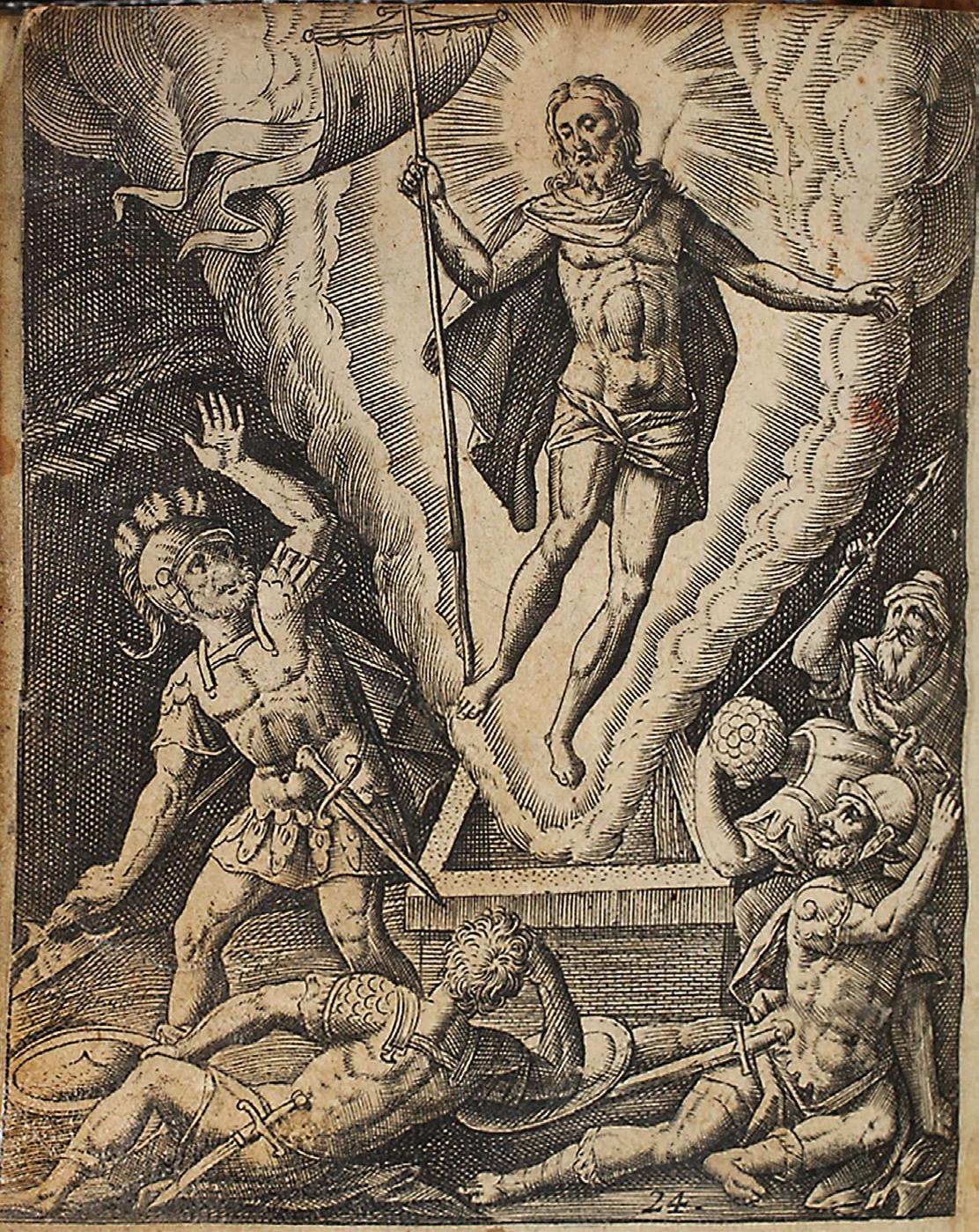
humanity’s parents, from whom we inherit original sin. Eve is closest to Christ; she is completely naked but with her long, curly hair adding an element of modesty. Adam is at her side, partially clothed. The image is gruesome, but Eve and Adam in the frame reveal that between his death and resurrection, Christ descends to rescue sinners from the searing flames of hell.
Station 24: The Resurrection
The prayerbook’s Station 24, its last, brightens the story of salvation. Christ still bears the victory flag as he rises above the guards who had been set outside the tomb (Matthew 27:62–66). The barely clothed, muscular
relates the same, as the exorcist prays: “Almighty and ever-living God, you sent your only Son into the world to cast out the power of Satan, spirit of evil, to rescue man from the kingdom of darkness, and bring him into the splendor of your kingdom of light. We pray for these children: Set them free from original sin and make them temples of your glory” (#49).
Icon: Descent to the Dead
Christ rises over the tomb’s dark prison into freedom’s bright glory.
The images fill in the Bible’s gap between empty tomb and resurrection appearances, confirming for us reciters of the Apostles’ Creed that “he descended into hell” (Station 23), then “on the third day he rose again from the dead” (Station 24). Both depict the Roman Missal’s theology that Jesus Christ “paid Adam’s debt to the eternal Father, and, pouring out his own dear Blood, wiped clean the record of our ancient sinfulness” (Exsultet).
The Church’s Prayer of Exorcism and Anointing before Baptism
In contrast to the death-descentresurrection sequence of the Viennese prayerbook and the Roman Missal, many Christians profess the descent and the resurrection as the same saving act. The descent captures not Christ’s descent to save sinners from hell but rather his descent to preach the good news to those who had lived before the incarnation (1 Peter 3:19). The dead have a chance to hear the good news that they didn’t have a chance to hear when living.

Unlike Station 23, Mr. Aidan Hart’s icon [next page] (from the collection of Saint John’s Abbey) has Christ’s descent but no hellfire or devils.
Adam and Eve rise out of a tomb on the right. An Old Testament king and John the Baptist rise from a tomb on the left. Christ himself has burst through the doors of the underworld to proclaim the good news to those who lived before him. Under the doors is the hardware that kept the doors tightly shut: locks, doorknobs, hinges, and nails.
Spring 2023 Abbey Banner 10 11
Station 23, Descent into Hell Station 24, Resurrection Kacmarcik MS 13 1622 Arca Artium Collection. Hill Museum & Manuscript Library. Used with permission.
The Blessing of Baptismal Water at Easter echoes this theology in its prayer: “May the power of the Holy Spirit, O Lord, we pray, come down through your Son into the fullness of this font, so that all who have been buried with Christ by Baptism into death may rise again to life with him” (#378). So too the antiphons of the Orthodox Easter: “Christ is risen from the dead, trampling death by death, and to those in the tombs, giving life.”
The absence of a resurrection story in the Bible and the variety of theologies of the resurrection in these images call us to ask of ourselves: Who rises at Easter? Does Christ rise alone? Does Christ rise only with those who have accepted Jesus as their personal Lord and Savior? Does Christ rise only with saints—or with both saints and sinners? Does Christ rise only with the baptized?
In the monastery, does Christ rise only with monks? In our parishes, does Christ rise only with those in our community?
Or—as we confess “the Lamb of God who takes away the sins of the world” at Communion and as in the bright, shining icon—does Christ rise with all humanity, from Adam and Eve in the garden at the beginning to us here and now?
Blessed Easter rising to all in Christ!
Dr. Martin F. Connell is professor of theology at Saint John’s University.
Urbi et Orbi Easter Message
The world proposes that we put ourselves forward at all costs, that we compete, that we prevail. But Christians, by the grace of Christ, dead and risen, are the seeds of another humanity, in which we seek to live in service to one another, not to be arrogant, but rather respectful and ready to help.
This is not weakness, but true strength! Those who bear within them God’s power, God’s love, and God’s justice, do not need to employ violence; they speak and act with the power of truth, beauty, and love.
May the marginalized, the imprisoned, the poor; the migrants who are so often rejected, maltreated, and discarded; the sick and the suffering; children, especially those who are victims of violence; all who today are in mourning, and all men and women of goodwill, hear the consoling voice of the Lord Jesus: “Peace to you!” (Luke 24:36). “Fear not, for I am risen, and I shall always be with you” (Roman Missal, Entrance Antiphon for Easter Day).

BRUTUS AT CALVARY
Kilian McDonnell, O.S.B.
Then all the disciples deserted him and fled. Matthew 26:56
I’m Matthew, tax collector, coward. But now I’m brave and write the truth. Back then, like the others, I turned my back and with them ran down the mount with a sackfull
of reasons. Luke finds my version of the truth too raw, cooks the story for tender souls; “acquaintances and women stood at a distance.”
The bloody truth: we men betrayed him to terror of the nails, were nowhere near the hill, while women stood fast.
We were more than friends. Noble Brutus also had his reasons.
THE NEWS THAT CAN’T BE TOLD
Kilian McDonnell, O.S.B.
When the sabbath was past, Mary Magdalene, and Mary the mother of James, and Salome, bought spices, so that they might go and anoint him. Mark 16:1
While it was still night we started toward the tomb with spices and oil to anoint our Rabbi’s body.
Inside the tomb we saw an angel sitting clothed in garments blazing white as though he had swallowed the sun. Even if it defies all logic, we were there beside him standing in the center of the sun. The angel said, He is risen, go, tell Peter!
Stupefied by fear
stupefied by rapture we fled, told Peter nothing. From Wrestling with God by Kilian McDonnell, O.S.B.
Copyright © 2011 by Order of Sant Benedict. Published by Saint John’s University Press, Collegeville, Minnesota. Used with permission.
Abbey Banner 12
You There?
Were
13
Alan Reed, O.S.B.
Resurrection icon by Aidan Hart
Pope Francis, 5 April 2015
Forest Vernal Pools
John Geissler
Abundant winter snows equate to a wet spring in the woods. The meltwater flows downhill and, in many cases, collects or is held in isolated depressions of our rolling Avon Hills landscape. We are fortunate to have over one hundred of these temporary water bodies, known as vernal pools, scattered throughout the Saint John’s Abbey Arboretum. As temporary aquatic environments, they offer unique and important spring habitat.
One of the biggest advantages for the egg-laying critters that use these vernal pools is that they are free of fish. Fish love to eat eggs and larvae! One of the biggest challenges for those looking to take advantage of this habitat is their fleeting existence—the pools often completely dry up by midsummer, or during dry years, they do not form at all. When we take a closer look, we will find that the organisms that rely on these ponds have made some remarkable adaptations.
It is easy to find vernal ponds in a wet spring—just listen for the loud breeding calls of the wood frogs, chorus frogs, and spring peepers. These relatively small woodland frogs overwinter as land-dwelling adults, thaw out from an almost completely frozen state in the leaf litter, and immediately make their way to the vernal pools to breed. The frogs lay their eggs quickly
because they know that time is of the essence. Their offspring must transform from aquatic eggs to gilled tadpoles and finally metamorphosize to airbreathing land-dwelling adults before the water dries up. It is a race against time.
More difficult to detect are the silent salamanders that also migrate to these pools in the spring to breed and lay eggs. The abbey arboretum is home to two types of these secretive salamanders. The smaller bluespotted salamander and the larger tiger salamander are both celebrated finds when our stewardship team encounters them. We were lucky enough to see both species last summer. As
with the frogs, salamanders are sensitive to pollutants, and their presence is an excellent indicator of good habitat health.

Another indicator of healthy vernal pools—and one of my favorite critters to find and show others—are fairy shrimp. Yes, you read that right! There are small freshwater shrimp in Minnesota forests! How do these ½- to ¾-inch freshwater shrimp get to these isolated forest ponds? The answer is that the shrimp eggs are already there in leaf litter of the forest depression waiting for the right conditions to hatch. Amazingly these durable eggs, known as cysts, can withstand being completely dried out, frozen, and dormant for years or even decades. Once the conditions are right, however, they can hatch within 48 hours of the pool forming and will be able to breed and lay more eggs in only three weeks. Just in case the wet conditions won’t last long enough, only a small percentage of the available cysts hatch every time the pool fills. We have found these fascinating crustaceans in several of the abbey arboretum’s vernal pools. It is one of the coolest creatures to watch swim around with its eleven sets of swimming legs gracefully propelling it through the water!
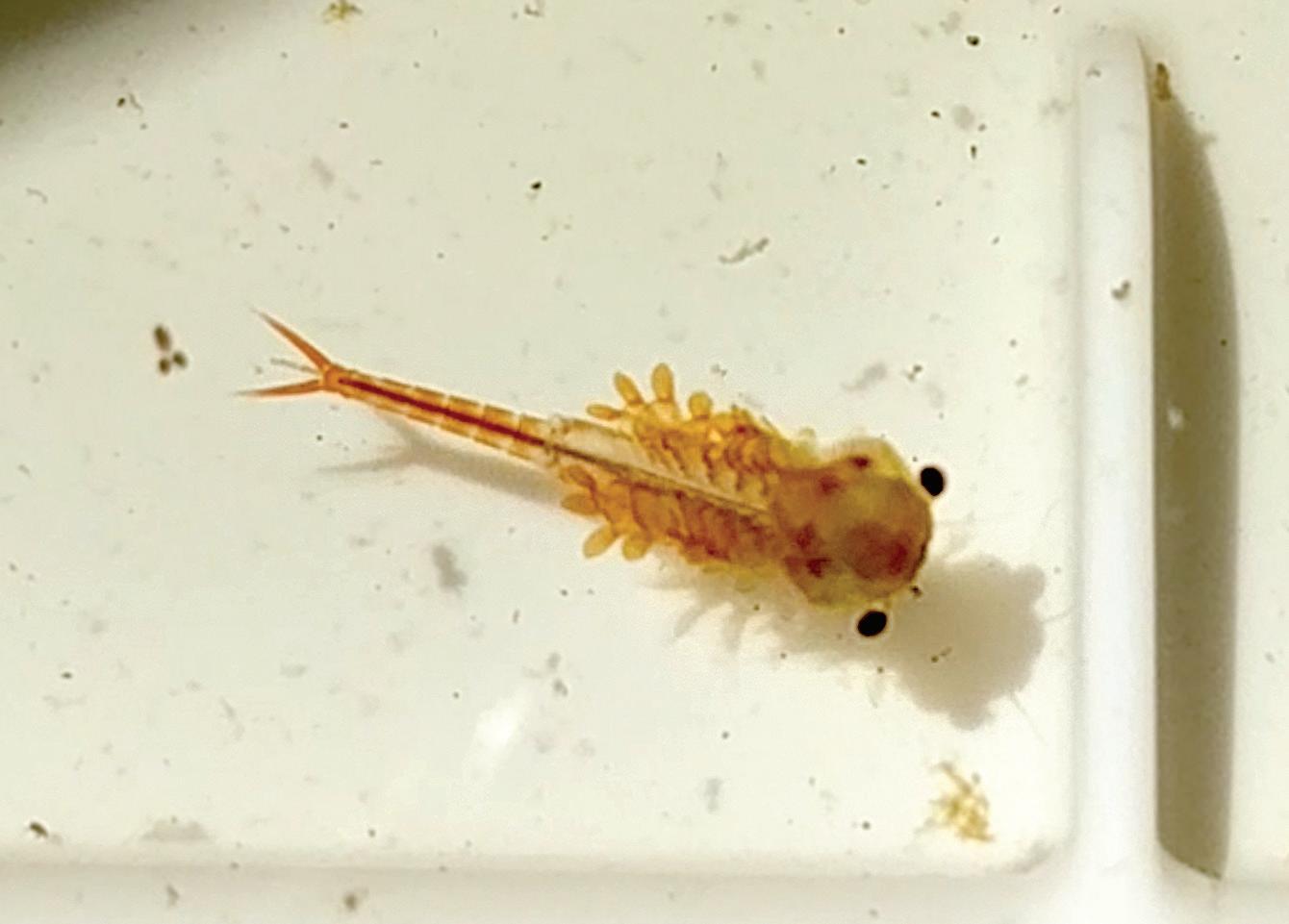
Vernal pools are also recognized as important habitat for the Blanding’s turtle, a threatened species that has been proposed as the official Minnesota state reptile. There are stories of past

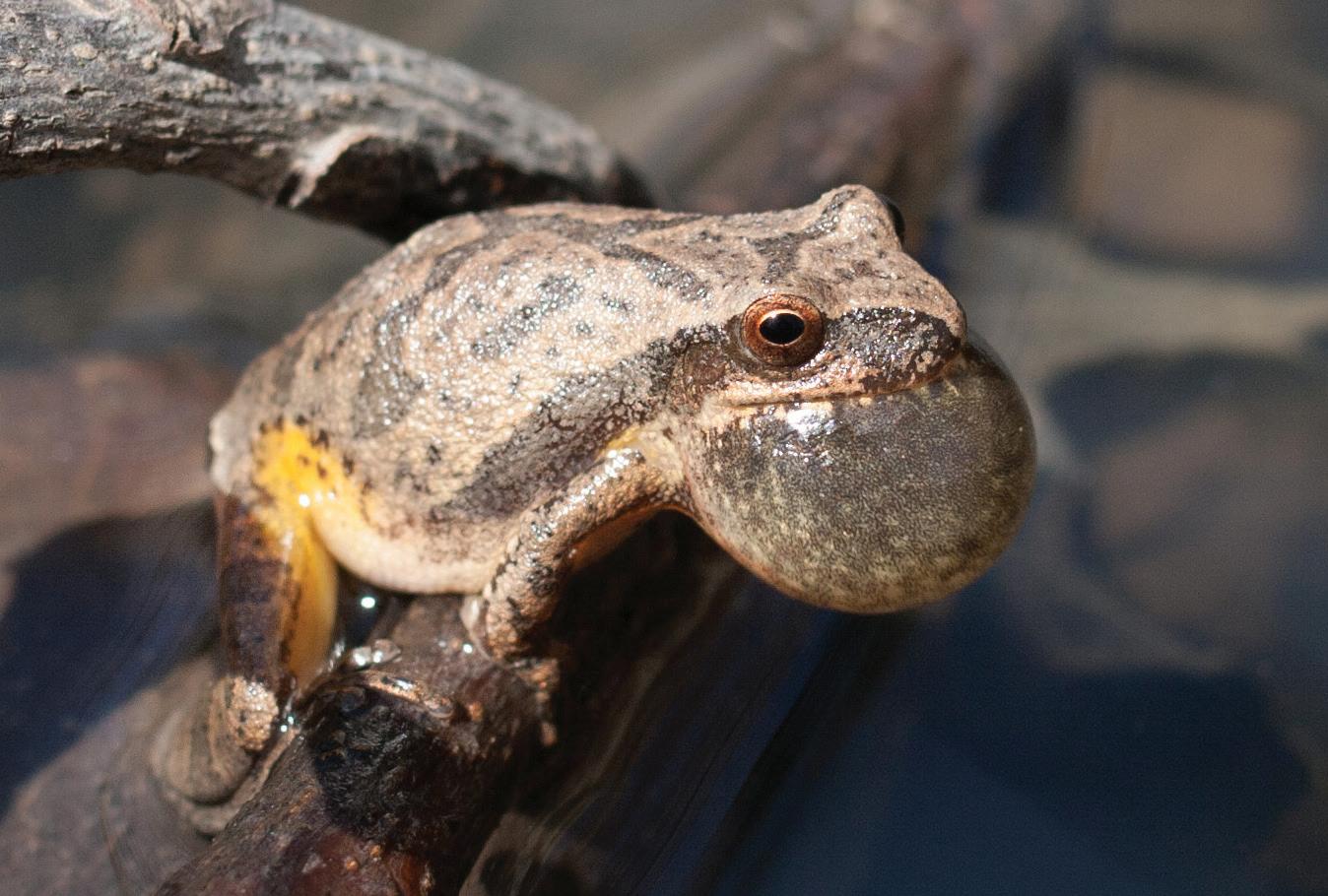
Spring 2023 Abbey Banner 14 15
Spring peeper (Pseudacris crucifer)
Justin Meissen/Wikimedia Commons
John Geissler
John Geissler
Tiger salamander (Ambystoma tigrinum)
Fairy shrimp (Branchinecta lynchi)
Andrew C/Wikimedia Commons
Blanding’s turtle (Emydoidea blandingii)
staff sightings of this turtle in the abbey arboretum. I personally saw one in the area four years ago, but unfortunately it was not in the abbey arboretum. If any of our readers ever happen to see one of these rare, highly-domed, shelled woodland turtles in the abbey arboretum, please let me know—and bring me a photo. I might buy you a pizza! (You can tell I work with college students a lot—pizza is the ultimate incentive!) In the meantime, we will continue to protect and enhance the habitat surrounding our vernal pools for all the hidden life that depends on these sensitive forest areas.
Mr. John Geissler is the land manager of Saint John’s Abbey and director of Saint John’s Outdoor University.
Abbey Conservation Corps

The members of the Abbey Conservation Corps work every Wednesday, 1:00–3:00 P.M. Meet in Science Lot #1 to join this fun group doing meaningful work in the Saint John’s Abbey Arboretum.

We need help planting trees this spring! We plan to plant and protect 2000 tree seedlings again this year. We also need help planting wildflowers and grasses! Over 2100 native pollinator wildflowers and grasses have been started in our greenhouse to enhance existing pollinator plantings and start new projects. As soon as we get all the trees in the ground, we will start planting these plugs.
Leave a Legacy Tree Planting
April 29, Saturday: 9:00 A.M.–3:00 P.M.
May 1–5: 8:00 A.M.–4:30 P.M.
May 8–12: 8:00 A.M.–4:30 P.M.
Those interested in assisting with any of these projects—or wh0 may have a group that would like to come out and help—please contact Abbey Land Manager John Geissler: jgeissler001@csbsju.edu
Those who can’t come out to help but would like to support our work, please consider a donation to the Forest Renewal Fund: https://saintjohnsabbey.org/abbey-forest-renewal-fund
Sacred Ground
In the beginning, when God created the heavens and the earth, the earth was a formless void and darkness covered the abyss.
Genesis
The local landscape, sacred to Indigenous peoples, was shaped by glaciers that created rolling hills, lakes, and prairie potholes. Streams formed channels through the land, including the North Fork of the Watab River (Stumpf Lake). The fieldstone deposited by the glaciers was used by pioneer monks to form the foundation of the Quadrangle and later to create stone walls across the campus.
Humans hunted and gathered here shortly after the glaciers receded. Since the 1600s Native American tribes, including the HoChunk, Dakota, and Ojibwe, lived in what is now the state of Minnesota. During the 1760s the Indigenous peoples were pushed west by white settlers and other uprooted Indigenous nations. Through a series of treaties drawn by the U.S. government, borders shifted before settling under American control, and reservations for the Ojibwe were created in
central and northern Minnesota. Though the Dakota and Ojibwe ceded the southern half of the Minnesota Territory, including present-day Saint John’s, the Dakota never received annual investment income as promised. When the United States closed several of the reservations, the Ojibwe were forced to live on even less land.
This sacred ground stands at the intersection of hardwood forest and prairie. The Nature Conservancy has identified it as “ecologically significant,” one of the few areas in the nation with intact, native plant communities. Saint John’s honors with gratitude this land and the Ho-Chunk, Dakota, Ojibwe, and Anishinaabe peoples who have stewarded it for generations.
This land acknowledgement statement, drafted by monks of Saint John’s Abbey, was approved by Abbot John Klassen, O.S.B., and the abbey’s senior council in October 2021.
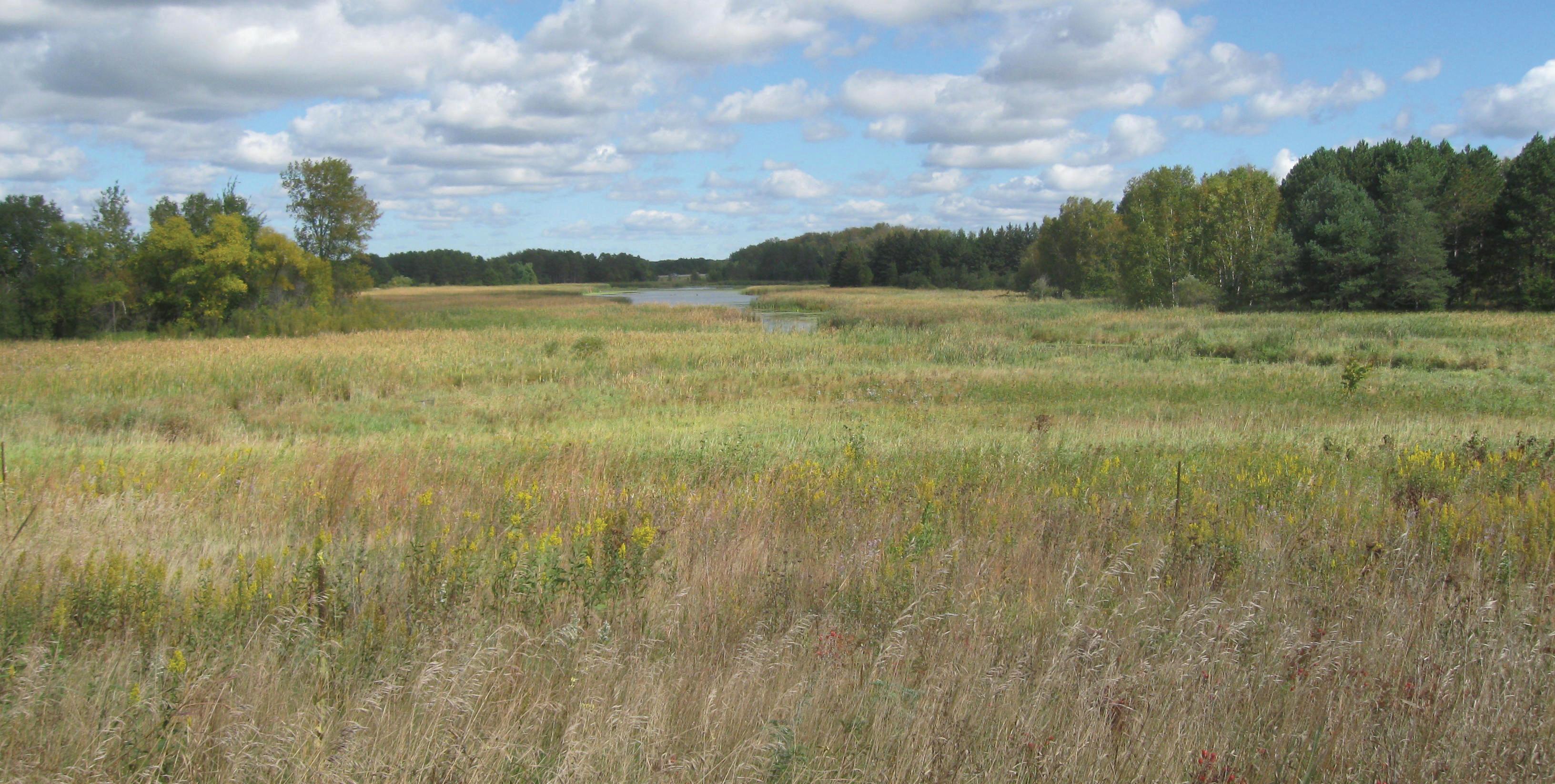
Spring 2023 Abbey Banner 16 17
1:1
John Geissler
John-Bede Pauley, O.S.B.
Benedictine Volunteer Corps
Puerto Rican Lessons
Joseph Stangler
If I can make it through hurricane season, I think I should be all right.
Irepeated this comment only half-jokingly to friends and family when asked about my upcoming journey to Colegio San Antonio Abad in Humacao, Puerto Rico, with the Benedictine Volunteer Corps (BVC). Every year during the fall months, this island territory is featured in the United States mainstream media due to the large-scale storms. The hurricane reports usually capture the attention of mainland U.S. residents for maybe a week. To the people who call Puerto Rico home, however, these storms take on a level of seriousness much greater than I ever imagined. Formerly I was fearful of how a hurricane might negatively affect my year of service. Looking back, I now realize that it was those chaotic winds that sent me down the correct path, the heavy rain that ultimately made my vision clear.
Chaos, destruction, and unpredictability put my Benedictine training to the test. Following Hurricane Fiona (a category 4 hurricane, September 2022), the first two weeks of October were the epitome of ora et labora (prayer and work) for me. With no electricity and no distractions, I got to work hauling away hundreds of palm branches,
unclogging the gutters, pressure washing, and putting everything back in its place. Teachers, students, and parishioners also gave their time to help this process, even though they inevitably were dealing with the same work in their own homes. This gave me a profound appreciation for the community that I was to call home for the foreseeable future. We prayed together every day— like we always do—but now with more guests and lots of specific intentions.
During those two weeks without power, we prayed, ate, and did almost everything while using flashlights and candles. Stories of past hurricanes occupied much of our dinner conver-

sation—stories about Hurricane Maria (category 5, September 2017), for example, and how it uprooted trees, devastated buildings, and left the monastery without power for seven months! Across Puerto Rico it caused over ninety billion dollars in damage and ended the lives of more than three thousand people. When I learned all of this, I recognized that the two weeks without power were really nothing at all. Through it all, the people of Puerto Rico showed resilience, confirming that hardships are only temporary. What is important is how we react to adversity and what life lessons we learn from them. I realize now that I had worried about something that would

ultimately give me the opportunity to grow.
Losing power is a hardship, but after the storm passed, I experienced the most blissful two weeks I’ve had in years. I was able to access an elusive mindset of peace that few experience because of the relentless distractions of today’s technology. One day in particular stands out. After morning Mass, I embarked on a special run that only people who enjoy endurance sports will understand—the kind of run that feels so good that you continue long after you pass the original goal. When I returned, I remember lying on a bench that I had never noticed. Looking up, I watched treetops dance in the breeze and colorful butterflies bounce in and out of my field of vision. I heard the song of a bird I’d never heard before, harmonizing with the rustling
leaves. I lay there for over an hour, positive that I was in exactly the right place.
Ever since that moment, Puerto Rico has felt like nothing short of home. As my Spanish has progressed, I am building better relationships with the monks, teachers, students, and maintenance workers who struggle with English. Through these relationships, the door has opened to new, exciting work opportunities. My teaching career has blossomed into a wide array of jobs, such as coaching the soccer team, freediving ocean cleanups, judging the spelling bee, restoring a lily pad pond, leading a volunteer club, building, painting, cooking, chauffeuring, tutoring, and more.
The BVC isn’t all work and no play. I have also had the pleasure of making friends—friends
who have been able to show me around the areas that are largely invisible from the resorts. I’ve explored massive caves below the earth and summited gorgeous peaks high in the clouds of Bosque Nacional El Yunque (the only tropical rainforest of the U.S.). I’ve experienced the rich history of Old San Juan. My snorkeling adventures have taken me within arm’s reach of some of the most beautiful yet terrifying marine life—including sharks, moray eels, rays, barracuda—and even closer with some jellyfish (ouch!), as well as some of the ocean’s friendlier company: sea turtles, parrotfish, and hundreds of other fish I couldn’t name. In Puerto Rico’s marine reserves, I have surfed, spearfished, jumped off cliffs, and swung from ropes.
The Benedictine Volunteer Corps has given me the opportunity to grow more than I could ever have by heading off to work right after college. By developing meaningful relationships with the monks, students, and other volunteers across the world, I have learned what it means to foster love through the work of my own hands and heart. The beauty of this island territory resonates with me deeply and will forever be a part of me. All that I had to do was make it through hurricane season.
Spring 2023 Abbey Banner 18 19
Mr. Joseph Stangler, a biology major from Clear Lake, Minnesota, is a 2022 graduate of Saint John’s University.
Restoring a lily pad pond
BVC
archives BVC archives
Cleaning up after a hurricane
Alfajiri Art


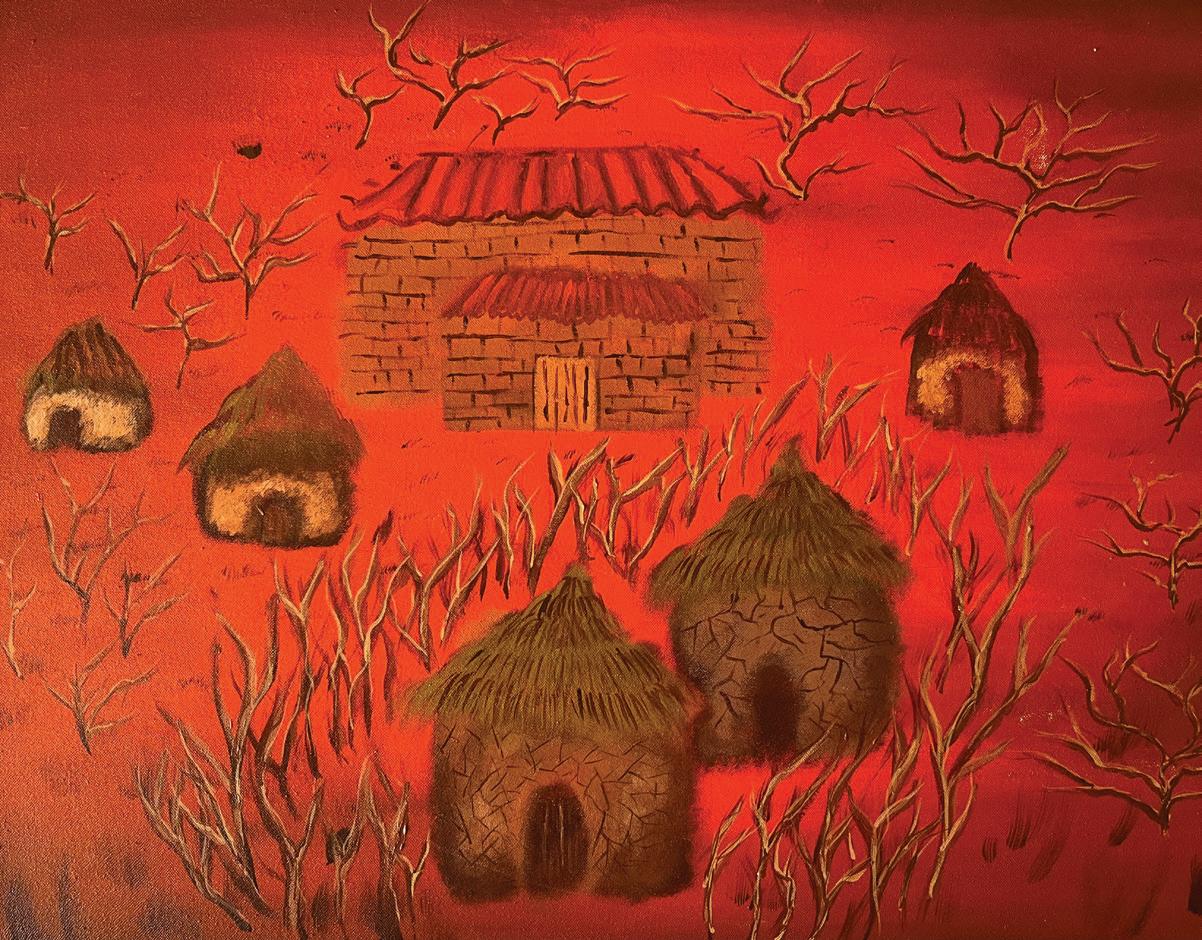


“In the tender compassion of our God, the dawn from on high shall break upon us, to shine on those who dwell in the shadow of death, and to guide our feet in the way of peace.”
Alfajiri (Swahili for daybreak) is a nonprofit organization in Nairobi, Kenya, founded specifically for art creation. Alfajiri offers art therapy-based outreach programs for at-risk, vulnerable children and youth, especially those living in the streets and slums of Nairobi. Benedictine Volunteer Corps (BVC) members work closely with Alfajiri in support of its mission and build strong connections with the children they serve.


Like Zechariah, Alfajiri and the BVC seek to bring the daybreak of the light of God’s love and compassion to the children of the Mathare Slum. To watch these children recover, to see them become a witness of hope for their fellows, and to see their suffering blossom into joy and creativity has been one of the greatest epiphanies of my life.
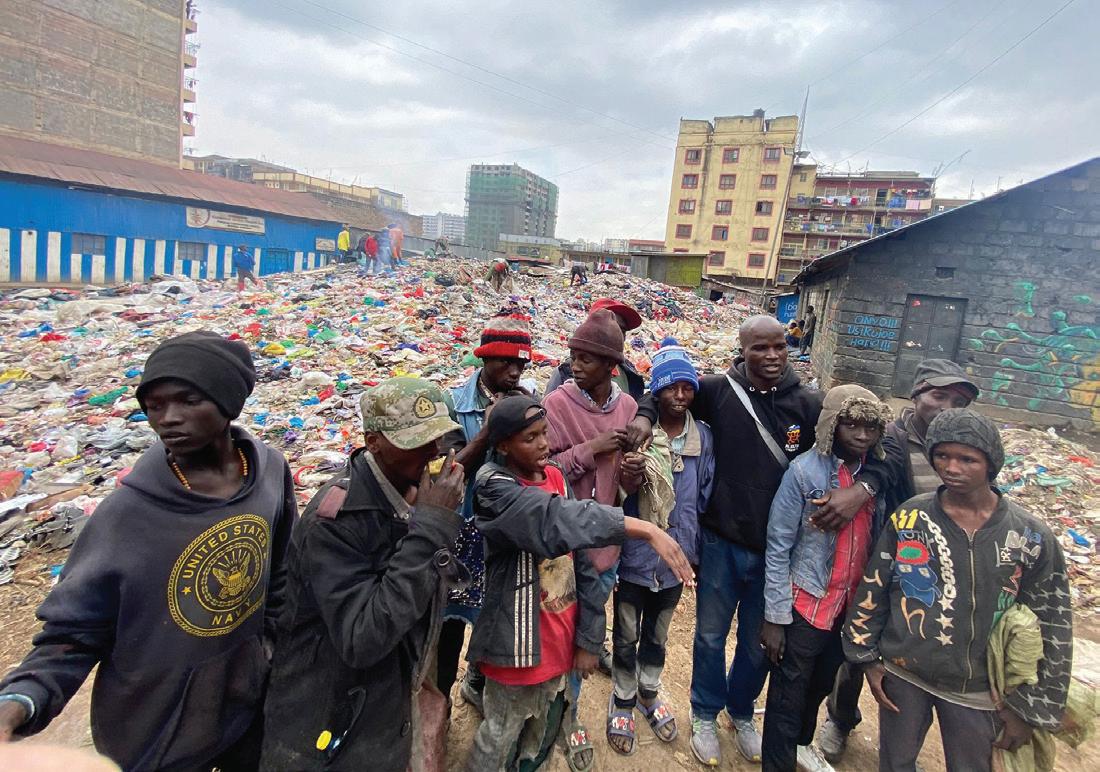 Joseph Luedke, Benedictine Volunteer, 2022–2023
Photos: Benedictine Volunteer Corps archives
Zechariah, Luke 1:78–79
Killer Cop by Juma
Heartcatcher by Nicolas Maina
Diving Whale by Juma
Desert Manyattas by Yusuf Mirembe
Joseph Luedke, Benedictine Volunteer, 2022–2023
Photos: Benedictine Volunteer Corps archives
Zechariah, Luke 1:78–79
Killer Cop by Juma
Heartcatcher by Nicolas Maina
Diving Whale by Juma
Desert Manyattas by Yusuf Mirembe
The Weber Brothers
Aaron Raverty, O.S.B.
In the popular imagination, monks are retiring figures, pursuing silence, immersed in prayer at the expense of action. But the Weber brothers—Fathers Arnold and Otto—failed miserably to fit that stereotype! As bold pioneers of monastic life at Saint John’s Abbey, these brother monk-priests were innovators and instigators who served the people of God with unique gifts and vibrant outreach programs.
Like the German American Gertken family of central Minnesota, which contributed eleven members to the Order of Saint Benedict, six Weber siblings (including Arnold and Otto) also took vows as Benedictines.
Arnold Weber was born on 21 October 1925 on a farm near Saint Martin, Minnesota, the same town where his parents were born. Sylvester (Father Otto) Weber was born on 17 January 1934 into this same farm family, where their first language was “Stearns County German.” Four of their sibling sisters chose consecrated religious life at Saint Benedict’s Monastery, Saint Joseph, Minnesota: Sister Jane, Sister Bernadette, Sister Helen, and Sister Marcella. Their childhood devotional milieu was shaped by their mother, Louise (who regularly quizzed them on the Sunday sermons), and by their father, Bernard (who was known for his lengthy prayer of blessing before supper—if you didn’t
have an appetite before the meal began, claimed Father Arnold, you certainly had one by the time the prayer was completed!).
Arnold Weber, O.S.B. (1925–2012)
In his autobiographical sketch, Arnold remarked about trying to rid himself of the “Germanisms” (accents) in his speech as a young man. From his earliest days, he enjoyed athletics and even considered participation in sports integral to preparation for the priesthood. Following a rural grade school education, he entered Saint John’s Preparatory School in 1940. In addition to the academic curriculum, which he highly esteemed, Arnold excelled at athletics. He was captain of the basketball, baseball, and football teams, and he added wrestling to his sports review. His athletic prowess earned him the monikers “Muscles” and “Monk” from his peers. Upon graduating from the prep school in 1944, he matriculated
into Saint John’s University. Here he played basketball and baseball, successfully building on his outstanding prep experience. He also became involved in theater, both as an actor and a stagehand.
Arnold apparently enjoyed being part of a larger group of likeminded associates with a singular goal. This is evident in his love of team sports. In addition, he joined several student clubs at the university, including the Kilmer Club, the Spalding Club, and the Chesterton Club, all of which related to public speaking, literature, and debate. He was also drawn to the Saint John Berchmans Society (altar servers), the Latin Club, and the radio club. His enthusiasm and leadership earned him the additional title of class president. He received a bachelor’s degree in philosophy in 1948.
Arnold entered the novitiate at Saint John’s Abbey in 1945. His youthful initiative, enthusiasm, and desire to direct others were showcased—not always happily —in his relations with fellow novices. He professed his first vows as a Benedictine monk in 1946 and was ordained a priest in 1952. Following his ordination, Father Arnold devoted several summers to earning a master’s degree in family sociology from The Catholic University of America.
While a prep and undergraduate student, Arnold worked on his home farm during the summers. His work at the bowling alleys at the university eventually earned him the title of manager. From an early age, he declared his love for both missionary work and manual labor. During his illustrious career, he was secondary school teacher, coach, administrator, pastor, retreat director, and abbey vocation director. Along with his brother, Otto, Arnold founded the Saint John’s Summer Leadership Camps in 1959.

Father Arnold became president of Benilde-St. Margaret’s High School, Saint Louis Park, Minnesota, in 1977, having earlier served as

the school’s religious education director. He is both beloved and lauded for rescuing Benilde-St. Margaret’s from closing and recognized for enhancing its overall operations. From 1981 until his retirement two decades later, he was pastor of Holy Name of Jesus parish, Medina, Minnesota. Here he built a bold parish complex, including a new church, rectory, and a gymnasium and classrooms for the parish school. In honor of their pastor, the parishioners established Arnie’s Door, a fund for those who came to the parish seeking assistance for urgent needs.
Father Arnold launched a special needs ministry at Holy Name in 1985 and later spearheaded a broad expansion of parish ministries.
Arnold seemed to have had the Midas touch at his assignments at Benilde-St. Margaret’s and Holy Name of Jesus. Both school enrollment and parish membership increased significantly under his leadership. Holy Rosary Church in Detroit Lakes, Minnesota, where he served as pastor for four years (1973–1977), likewise benefited from his initiatives. Father Arnold fostered interreligious outreach by encouraging Jewish-Christian dialogue. Wherever he served as pastor he strove to introduce many of the liturgical changes prompted by Vatican II. He also became interested in Catholic Charismatic Renewal in the mid1970s, participating in several of their conferences.
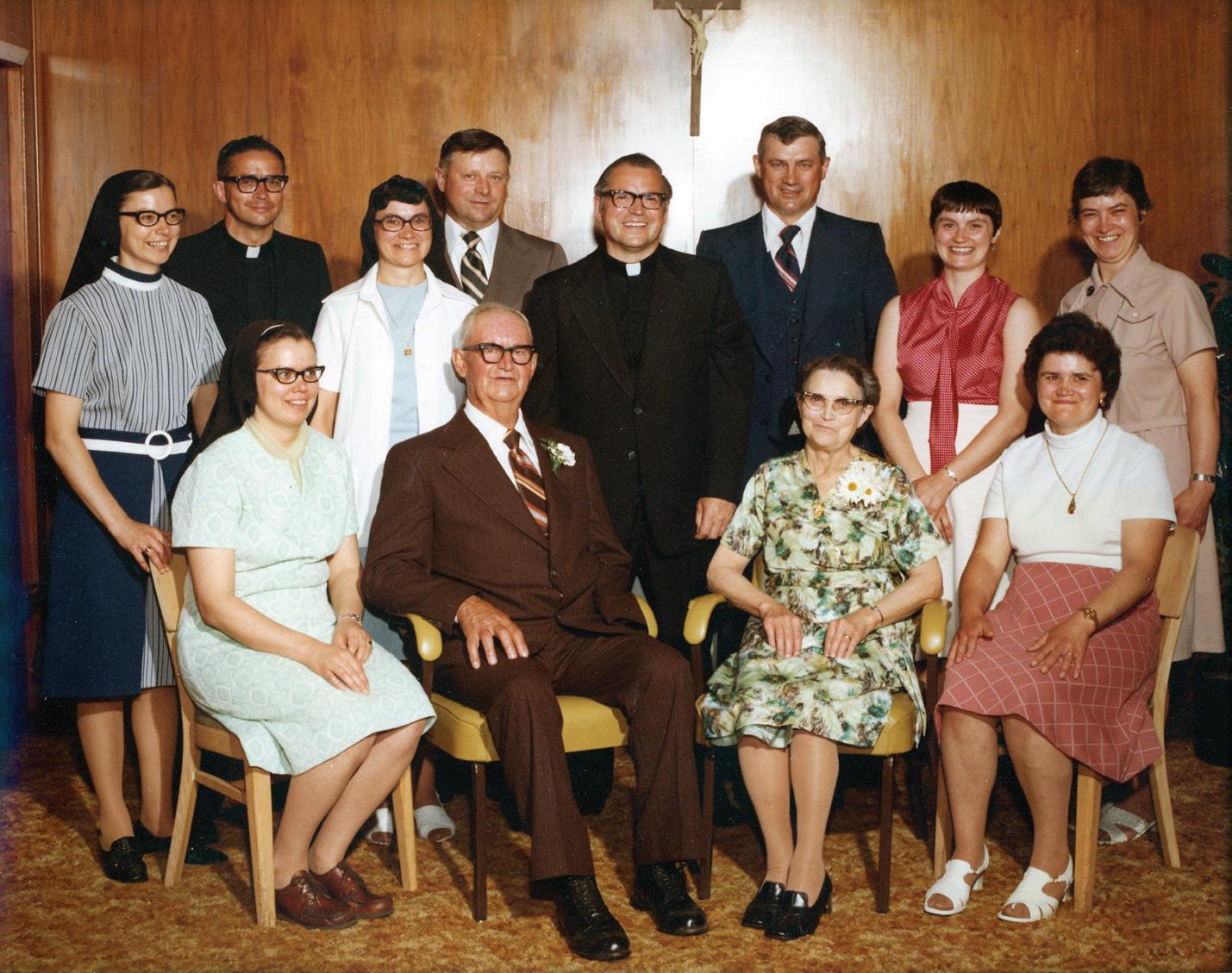
Spring 2023 Abbey Banner 22 23
University archives
Caufield, Detroit Lakes/Helen Weber, O.S.B./Saint Benedict’s Monastery archives
The Bernard and Louise Weber family, 1977
Father Arnold
Father Arnold with prep students University archives
Consistent with his missionary interests, Father Arnold was a world traveler, leading parish travel tours and pilgrimages to many countries of the world.
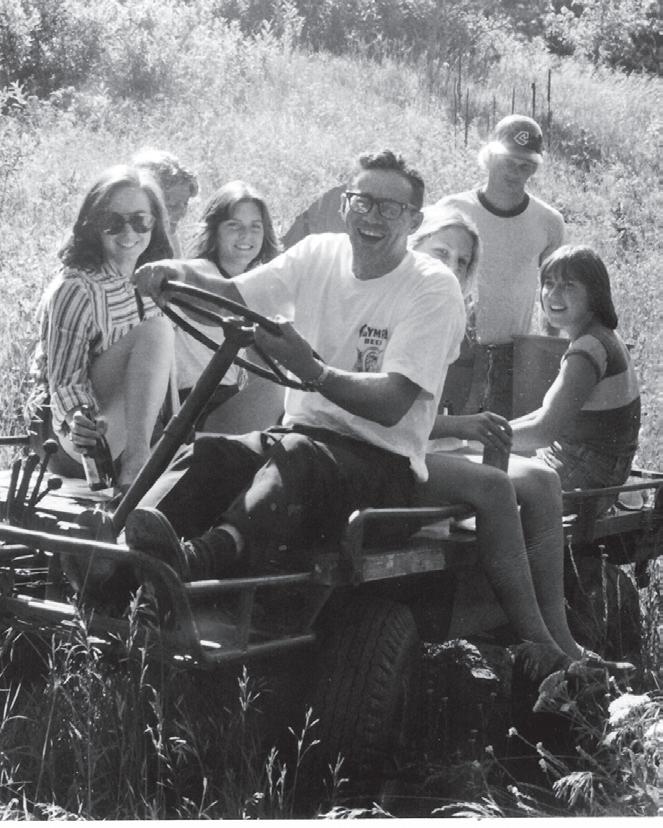
Following a distinguished life of ministry and service, Father Arnold died at Saint John’s heathcare and retirement center on 9 February 2012, age 86.
Otto
(Sylvester) Weber, O.S.B. (1934–1987)
Sylvester Weber enrolled in Saint John’s Preparatory School in 1948 and graduated in 1952. He continued his education at Saint John’s University, graduating with a bachelor’s degree in 1957. Upon entering the novitiate at Saint John’s Abbey, he was given the religious name of Otto. He professed his first vows as a Benedictine monk in 1955 and was ordained a priest in 1961.
In his handwritten autobiography, he largely credits his mother’s devotional influence in helping him make this decision, admitting that he was aware of his religious vocation as early as his grade school days.
During his career at the prep school, Father Otto held an array of jobs, including dean of students; Latin and theology teacher; dorm prefect; wrestling, football, baseball, and track coach; alumni activities coordinator; admissions director; and intramural sports director.

Along with his brother, he was the founder and subsequent director of leadership and sports camps and the summer camps organizer. Otto was also an employee of Saint John’s Abbey archives
Father Otto’s civic and athletic accomplishments were recognized during and after his lifetime. While an undergraduate, he won a Minnesota Intercollegiate Athletic Conference wrestling championship and was honored posthumously by the Minnesota Chapter of the national Wrestling Hall of Fame with a lifetime achievement award in 2019. The Hall of Fame Service Award was presented to him by the Minnesota High School Track Coaches Association. In recognition of his dedication and service to his “faith, community, and Saint John’s Prep,” the Saint John’s Preparatory School Alumni Association honored him with the Armor of Light Award

(1982), three years after the same honor was conferred on Father Arnold.

He readily accumulated the accolades of both peers and students. Over the years, many prep alumni asked him to preside at their weddings. Father Otto’s prep faculty colleague Mr. Peter Froehle commented that “he was a tremendous role model not only for the students but for many of us—his fellow teachers and coaches.” Prep alumnus Mr. Joseph Piché ’82 said that “Otto was able to teach and live a Catholic, Christian faith that could easily be received by young or old.”
University and had an office in the Warner Palaestra. Here he served as intramural sports director, building the university intramural sports program (beginning in 1975) and later serving as the director of the palaestra’s recreational programs.
Father Otto was a workaholic, motivated by a strong personal philosophy and reinforced by an indomitable drive and many strengths and gifts. He was well organized and deeply competitive, often touting what he referred to as the d-f-g method: discipline, flexibility, and generosity, which he claimed ultimately derived from the Rule of Saint Benedict.
Father Otto’s vigorous life ended suddenly and unexpectedly. He suffered a heart attack after his daily jog and died on 12 July 1987, age 53. In his eulogy for his brother, Father Arnold Weber observed: “He was a man of great simplicity, deep spirituality, and utter integrity.”
One of Father Otto’s personal quirks that I fondly remember was his unique twist in concluding the celebration of the Eucharist. In the dismissal, he sent the congregation on their way by declaring: “The Mass is endless; go in peace.”
Brother Aaron Raverty, O.S.B., a member of the Abbey Banner editorial staff, is the author of Refuge in Crestone: A Sanctuary for Interreligious Dialogue (Lexington Books, 2014).
Spring 2023 Abbey Banner 24 25
Father Otto
Brothers celebrating Eucharist University archives
From his earliest days as a monk, Father Otto was an inspiration to youth.
Otto-mobile
University archives
Abbey archives
Patrick Henry
Not long after I first arrived at Saint John’s in 1975, the Brother Cadfael novels by Ellis Peters began appearing. I have since come to see that the monks and sisters I know personally are true descendants of the twelfth-century Cadfael. The author persuasively portrays the monastery as the center of the community, its walls a permeable membrane, its inhabitants a crew who know in their bones, and demonstrate in their lives, that the distinction between “life” and “spiritual life” is a category mistake. This is as true today in Collegeville and Saint Joseph as it was in medieval Shrewsbury.
I could write a book—and have done so!—detailing what I have learned from Benedictines. The essence of the lesson can be distilled into four memorable insights.


First, what Brother Dietrich Reinhart (1949–2008) said when the idea of The Saint John’s Bible was first presented to him: Beset with all the demands that swirl around a university president, Dietrich groaned, “I need this like I need a hole in the head!” Then, immediately, the Benedictine wonder burst forth: “But wouldn’t it be grand!”
Second, a line in one of the poems of Father Kilian McDonnell, founder of the Collegeville Institute: “All our
truths need bungee cords.” This same intuition was portrayed in a different image by Father Columba Stewart: “Being deeply rooted in a tradition, we Benedictines are able to be confident in opening ourselves intellectually and ecumenically because we don’t feel threatened by stuff that’s newer. We’re like a deeprooted tree—we can sway a bit.”
Third, Sister Jeremy Hall (1918–2008) lived as a hermit the last two decades of her life but continued to interact with her community. Not a shred of sentimentality. It was said after her death: “Sister Jeremy didn’t tolerate any bull**** when it came to God.” (I hope this can be said of me.)
Fourth, a revelatory remark made by a College of Saint Benedict student, shared by her teacher Sister Linda Kulzer (1929–2022): “We see the

Who Elects the Abbot?
Eric Hollas, O.S.B.
Saint Benedict is a paragon of wisdom, with sound advice strewn throughout his Rule. Regarding the selection of an abbot, however, he seems to have taken an odd turn. According to chapter 64, the monks select their abbot. If a unanimous vote is not in the offing, then a small group of the wiser monks should choose. It’s that simple, and I’m in awe of Benedict’s naïveté. Did he actually think this could work?
world in black and white. We take things for granted. The Benedictine sisters see the world in many colors.” Yes, Benedictines, like Saint Benedict himself, see the whole world gathered in a ray of light, for which the Rule serves as a prism to refract that ray into all its components.
Because of what I’ve learned at Saint John’s and Saint Benedict’s, I understand the theological and experiential truth articulated by Emily Dickinson: “I noticed that the ‘Supernatural’ was only the Natural, disclosed.”
Dr. Patrick Henry, executive director of the Collegeville Institute for Ecumenical and Cultural Research (1984–2004) and an oblate of Saint John’s Abbey since 1976, is the author of Benedictine Options: Learning to Live from the Sons and Daughters of Saints Benedict and Scholastica.
Throughout Benedictine history, the election of an abbot has never been a slam dunk. In the early Middle Ages nobles who endowed monasteries with land did so to gain prayers, develop unused parcels of land, and keep that land under their control by reserving the right to appoint the abbot. When Charlemagne and his son Louis imposed the Rule of Saint Benedict on the monasteries of the empire, their reform did not include the free election of the abbot. Historians suggest that by 800 only a handful of abbeys retained this right, while the rest accepted whoever was sent.
In time kings used abbatial appointments as one way to finance the salaries of government officials, and the thirteenthcentury Chronicle of Jocelyn of Brakelond provides a wonderful narrative of how this could work out in practice. Like many
wealthy English monasteries, the monks of Bury St. Edmunds could nominate one of their own to be abbot, and they nominated shrewdly. But the king reserved the right to name anyone, and sometimes he did. So pervasive did this practice become that absentee abbots became something of a norm. Compounding the problem were the cases of pluralism. Cardinal Richelieu (1585–1642), for example, was first and foremost a servant of the state, but the source of his income was as the abbot of Cluny (Benedictine), Cîteaux (Cistercian), and Prémontré (Norbertine), simultaneously! That rendered the office of abbot practically useless.
Monasteries did attempt reform, and notable was the fifteenthcentury Congregation of Santa Giustina of Padua. Given the degradation of the office of abbot, however, they replaced the prelateabbots with term-limited priors who acted as their father in Christ.
[Let the office of abbot] be conferred on the one who is chosen either unanimously in the fear of God or else by a part of the community, however small, if its counsel is more wholesome.
Rule of Benedict, 64.1
Today the election of an abbot is in the hands of the monks. When the monks of Saint John’s Abbey gather in 2024 to elect a new abbot, they will follow the regulations of the American-Cassinese Congregation of monasteries. The electors will be those in solemn vows, and among them will be at least a sprinkling of wise monks. When our community elects our father in Christ, it will be as Saint Benedict had hoped. Father Eric Hollas, O.S.B., is the prior of Saint John’s Abbey.
Title of Article Spring 2023 Abbey Banner 26 27 Memorable Insights
ule of Benedict
Aidan Putnam
Robin Pierzina, O.S.B.
Meet a Monk: Nickolas Kleespie
woodworker and handyman. From them Nick inherited his tendency to keep busy, fix things, and move constantly.
Growing up in a blended family, Nick experienced two faith traditions, the United Church of Christ and the Catholic Church. Having attended public school in nearby Morris, Nick’s first encounter with Catholic education would be Saint John’s University, where he arrived as a freshman in 2002. He had been a singer in choirs, so he pursued music and education as his fields of study, graduating in 2006.
to Saint John’s and its surroundings (“three thousand beautiful acres,” he says reverently) and especially to the people, the apostolates, and the rhythm of monastic life. He served as a faculty resident and assisted in the campus ministry office as well as with The St. John’s Boys’ Choir until one day, at the urging of a senior monk, he found himself applying for candidacy. He professed his first vows as a Benedictine monk on 11 July 2010, and following seminary studies, he was ordained to the priesthood in 2015.
serve the local neighborhoods. He also leads a small group of men known as “Johnnie Brothers” —meeting regularly to talk about their development as men and college students, their relationships, and what their faith means to them. Father Nick’s greatest contribution is engaging Johnnies, says senior Riley Berg. “He is a face that every Johnnie knows, and he is involved everywhere Johnnies go.”
in their training as professionals. For Nick and many other monks, ministering to students is a source of great satisfaction—and it has been a Saint John’s tradition since 1857!
Timothy Backous, O.S.B.
Having lunch with Father Nickolas Kleespie, O.S.B., goes something like this: in the middle of a lively conversation, you pause to take a spoonful of soup. When you look up, the chair across from you is empty! If you are quick enough, you might see the back of Nick’s head as he runs out the back door, responding to a fire or EMT (emergency medical technician) call. Father Nick is usually draped with technology befitting the many roles he plays at Saint John’s—roles that he performs with competence, energy, and passion.
Born in Ortonville, Minnesota, in 1984, Nick is one of five children, including his siblings, Melissa, Justin, Andrea, and Nate. Nick’s mother Sue is a nurse, and his stepfather Bill is a
The next fall Nick served in the Benedictine Volunteer Corps at the Abbey of Hanga in Tanzania, East Africa, an experience that nurtured his monastic vocation. He recalls, “There were many young monks who loved to talk about faith and how excited they were to live as monks.” Besides his conversations with them, he was moved by praying compline with them in a dark, candle-lit church—each evening service was “brief but mystical.” He left Africa with a marked attraction to Benedictine life because of that year. Upon his return to the U.S., Nick felt drawn
Father Nick was assigned to be the chaplain for Saint John’s University—a role he likens to being a pastor of the student “parish.” His primary duty is presiding at the Sunday (9:00 P.M.) student Mass, which has become a venerable tradition of Saint John’s and draws large

numbers of participants each week. Two variations are known as “Mass on the Grass,” which takes place on the lawn between the church and the library, and the “Ice Mass,” which is held (where else?) on frozen Lake Sagatagan. The inaugural version of this latter event was so popular, it drew an unexpectedly large crowd and made state and national headlines. (This is not a fish story!) Each fall Nick adds the title of “football chaplain” to his résumé, when the Johnnie football team gathers for Mass before each game. It is a tradition that dates to Coach John Gagliardi’s tenure and is now sustained by Coach Gary Fasching.
In addition to presiding at the Sunday Eucharist, Father Nick organizes and participates in formal retreats and service/ immersion trips, including an annual work excursion to The Bahamas where the participants


Of the many hats Father Nick wears, the most meaningful for him is his work as a firefighter and an emergency medical technician. Not only does this service offer him a chance to treat others in a medical crisis, but it also allows him to work more closely with students on both teams, ministering to them
It is no mystery why one who joins Nick Kleespie for lunch often faces an empty chair. He considers service to others as far more important than eating. But his roles of chaplain, emergency medical technician, firefighter, faculty resident, Johnnie Brothers mentor, service/immersion guide, cantor, and director of the abbey schola (choir) all pale in comparison to his ultimate love: monastic life itself. As a Benedictine, he is able to do “really good ministry with really good people” and surround himself with deep friendships within and outside the monastery.
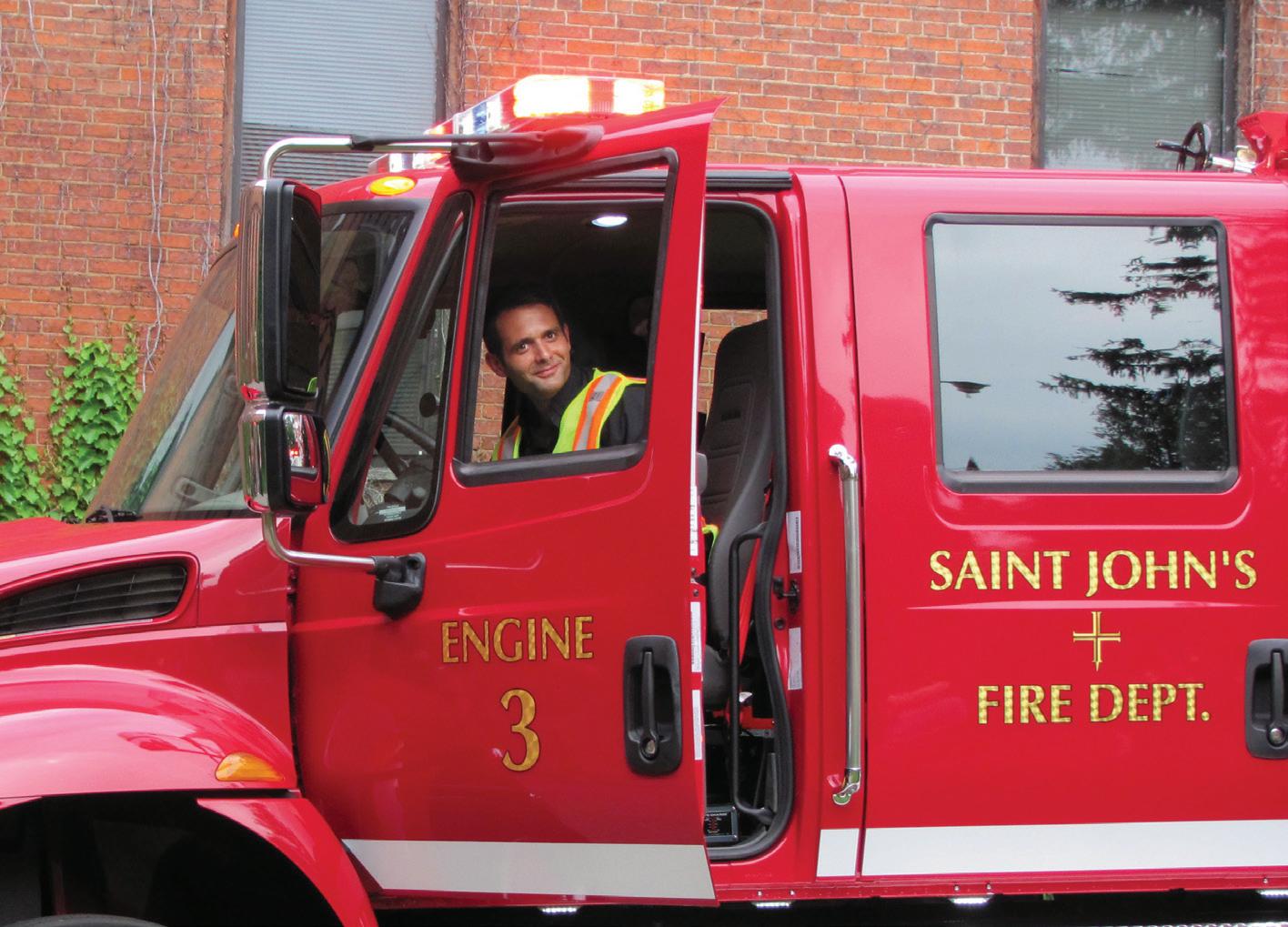
Spring 2023 Abbey Banner 28 29
Robin Pierzina, O.S.B.
Robin Pierzina, O.S.B.
Father Nick blesses the Stella Maris Chapel trailhead marker.
Mathare Slum, Nairobi BVC archives
Father Nick on the alert Robin Pierzina, O.S.B.
Prayer of Saint Francis de Sales (1567–1622)
Do not fear what may happen tomorrow. The same everlasting Father who cares for you today will take care of you then and everyday. He will either shield you from suffering, or will give you unfailing strength to bear it. Be at peace!
Put aside all anxious thoughts and imagination.
Prayer of Saint Teresa of Ávila (1515–1582)
Let nothing trouble you, let nothing frighten you. All things are passing; God never changes.
Patience obtains all things. The one who possesses God lacks nothing: God alone suffices.
Prayer of Saint Augustine of Hippo (354–430)
Watch, O Lord, with those who wake, or watch, or weep tonight, and give your angels and saints charge over those who sleep.
Tend your sick ones, O Lord Jesus Christ. Rest your weary ones. Bless your dying ones.
Soothe your suffering ones.
Pity your afflicted ones. Shield your joyous ones; And all for your love’s sake. Amen.
What Is Life?
Crowfoot, Chief of the Canadian Blackfoot
It is the flash of a firefly in the night. It is the breath of a buffalo in the wintertime.
It is the little shadow which runs across the grass and loses itself in the sunset.
(Crowfoot’s Last Words, 1890)
Father Jonathan Fischer, O.S.B., was the third of seven children born to Wendelin Matthias and Rosemary (Engel) Fischer in Strasburg, North Dakota, on 4 April 1934 and later baptized Francis.

After completing his elementary and high school education in Strasburg, he enrolled at Saint John’s University where he earned a bachelor’s degree in philosophy in 1957. As was the custom at the time for clerical candidates, Father Jonathan interrupted his undergraduate studies, entered the novitiate of Saint John’s Abbey, and professed his first vows as a Benedictine monk on 11 July 1955. He was ordained to the priesthood in 1961.
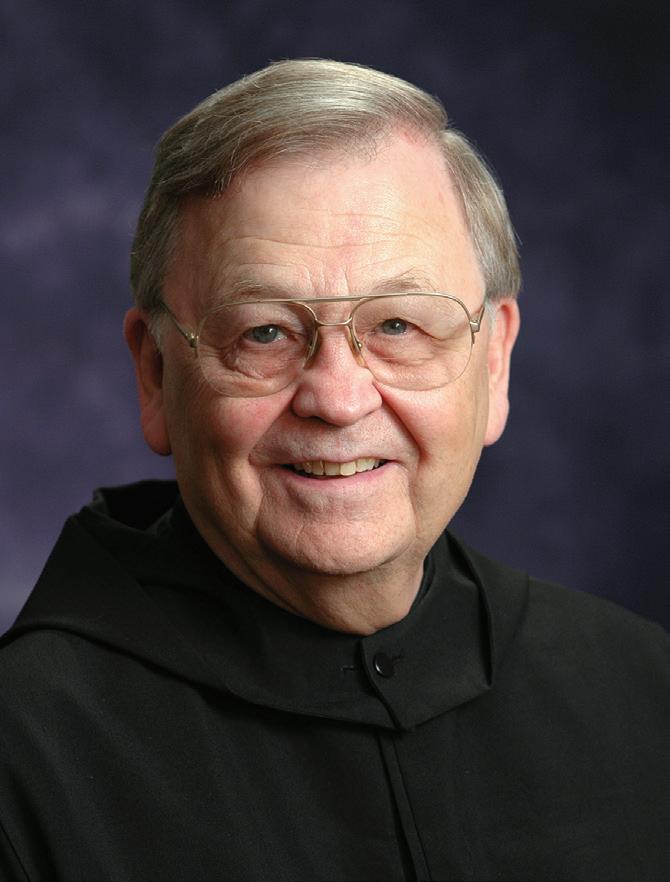
In 1965 Father Jonathan earned a master’s degree in German at Middlebury Language School, Vermont. He continued his studies in German the following year with the aid of a grant at the
University of Southern Illinois and was subsequently awarded another grant for German language study at the University of Munich. His German language and culture studies extended through 1969 at the University of Colorado. In 1988 he completed a unit in clinical pastoral education (CPE) at St. Mary’s Medical Center, Duluth, Minnesota.
Father Jonathan’s abundant talent and wide-ranging interests made him a successful administrator, educator, and pastoral minister throughout his decades of service. His spirituality was down to earth, matterof-fact. “Just do what you are supposed to do, for heaven’s sake. This is not rocket-science.”
At Saint John’s Preparatory School, Jonathan was a prefect (1961–1965), taught German and religion until 1973, and for one year served as the director of the student exchange program at Melk Abbey, Austria. Having grown up in the German environment of Strasburg and with years of formal education in the German language and literature, he proved to be a solid teacher.
Father Jonathan was pastor of the Church of Saint Joseph, Saint Joseph, Minnesota, and a chaplain of Saint Benedict’s Monastery, 1973–1979. He “found it a distinct privilege to work with these intelligent and prayerful women.” Beginning in 1979 he exercised his pastoral
skills at White Earth Reservation as pastor of St. Benedict Catholic Church, White Earth, Minnesota, as well as pastor at Most Holy Redeemer Church in nearby Ogema. Additional pastoral assignments between 1988 and his retirement in 2014 included service as a chaplain at Saint Paul metro-area hospitals: Divine Redeemer, St. Joseph’s, St. John’s, and Midway. He also gave generously of his time by conducting regular grief support groups.

In 1982 Father Jonathan was appointed field director in Germany and Portugal for what is now called the Hill Museum & Manuscript Library (HMML), where he oversaw medieval manuscript microfilm operations through 1987.
Following years of dealing with serious heart issues, Father Jonathan died on 11 January 2023, in the abbey’s healthcare and retirement center. He was buried in the abbey cemetery after his community celebrated the Mass of Christian Burial.
Father Jonathan Fischer: Deeply German, hardworking, reliable, steady, matter of fact, shy and quiet, unflappable, gentle and softspoken, affectionate, well-educated, always connected to his family.
Abbot John Klassen, O.S.B.
31
Title of Article
Prayers of the Faithful Jonathan Fischer
Spring 2023
30
Abbey archives
The daily routine within the cloister is enlivened by the antics of the “characters” of the community. Here are stories from the Monastic Mischief file.
Yes, in a variety of weights
At the end of his physical therapy session, the therapist asked Father Anthony: “Are there any dumbbells in the monastery.”
Monastic accounting
Sometime before 8:00 p.m., someone dropped some cash in the basement monastery corridor. If you can give me a plausible account for how you lost it and your estimate of what you lost is reasonably close to the amount I found, I will return the money to you. Father Prior
Archaeology
The June 1972 Confrere reports:
Father Alberic Culhane is spending another summer at Tel Gezer, Israel, as a field supervisor for an archaeological dig: as Father Alberic puts it, “My career is in ruins!”
They say
Reporter: How many people work at the Vatican?
Pope John XXIII: About half.
Abraham Lincoln after being called “two-faced”:
“If I had two faces, do you think I’d be wearing this one?”
I am bored with the future altogether and don’t want to hear any more about it.
Queen Victoria
I am fond of pigs.
Dogs look up to us. Cats look down on us.
Pigs treat us as equals.
Attributed to Winston Churchill
Lenten Observances according to Parish Bulletins
• Lent is coming. Get your ash in church.
• Don’t miss our special Lenten retreat next weekend. We’ll rest in God’s presence while learning about the Lethargy of the Hours.
• Remember! Ash Wednesday and Good Friday are to be observed as days of fast and obstinance.
• During Lent, our Friday suppers will feature holy macaroni and cheeses of Nazareth.
Aging Gracefully
Take this test to determine if you’re losing it or not. [Answers below.]
1. What do you put in a toaster?
2. Say “silk” ten times. Now spell “silk.” What do cows drink?
3. If a red house is made of red bricks, and a blue house is made of blue bricks, and a pink house is made of pink bricks, and a black house is made of black bricks, what is a green house made of?
4. Please do not use a calculator to answer this question. You are driving a bus from New York City to Philadelphia. In Staten Island 17 people got on the bus. In New Brunswick 6 people get off the bus, and 9 people get on. In Windsor 2 people get off, and 4 get on. In Trenton 11 people get off, and 16 people get on. In Bristol 3 people get off, and 5 people get on. And, in Camden, 6 people get off, and 3 get on. You then arrive at Philadelphia Station. Without going back to review, how old is the bus driver?
1. Answer: “Bread.” If you said “toast,” just give up now and go do something else and try not to hurt yourself.
2. Answer: Cows drink water. If you said “milk,” your brain may already be overstressed and may even overheat.
3. Answer: Greenhouses are made of glass. If you said, “green bricks,” please lie down!
4. Answer: Oh, for crying out loud! Don’t you remember your own age? It was you driving the bus!
Road trips
The road to hell is paved with good intentions.
The road to success is always under construction.
Lily Tomlin
Ice and snow, bless the Lord; Praise and exalt God above all forever.
Daniel 3:70
W inter 2023’s report card: C for cold, C+ for COVID positive, S for snow, snow, snow.
Nearly a foot of snow transformed Collegeville into a winter wonderland in midDecember, followed by another 5 inches on the winter solstice. Christmas cheer was chilled by a morning temp of -6°F and a windchill of -21. The first week of the new year brought another 14 inches of snow; the last week of January recorded windchills in the -20s and -30s. Saint Valentine warmed our hearts with a temp of 37 degrees (above zero!) and rain rather than snow showers, but Ash Wednesday was white as . . . snow. Dozens of robins arrived on campus on 6 March, a day after another 4 inches of snow fell. On the feast of Saint Patrick, only Irish ice was shining on a blustery day with a windchill of -15. No green to be seen.
Eighteen monks tested positive for COVID-19 during the first days of February, depleting attendance at prayer services and putting a damper on the community’s Super Bowl supper. Those who successfully resisted the latest upsurge in the scourge were rewarded with the task of feeding those in isolation. Father Dan Ward prepared homemade chicken noodle soup. Father
Cyril Gorman offered to sing and dance, at an appropriate distance, for those recovering—which occasioned a debate as to whether this would help or hinder the healing process!
April’s report card: A for Alleluia! Rain or snow, chill or warm, He is risen!

On 6 January, Gabriel (Blake) Gerrits, age 28, was clothed in the monastic habit and began his novitiate year of discernment of a Benedictine vocation. A native of Wisconsin, Novice Gabriel graduated from the University of Wisconsin-Stout (professional communications and emerging media, with a focus on photography). Most recently he worked at Jones Dairy Farm, Fort Atkinson, Wisconsin.

December 2022
• On 19 December the monastic community joined Saint John’s current and retired employees for their first Advent/Christmas party since 2019 and the beginning of the coronavirus pandemic. Besides greetings of “Merry Christmas and Happy New Year,” there were many proclamations of “Alleluia!”
Abbey Banner 32 Cloister Light Abbey Chronicle
Spring 2023 33
Félix Mencias Babian, O.S.B. March madness!
Robin Pierzina, O.S.B.
• To reduce the deer population to a level that allows both adequate regeneration of the forest and a healthy deer herd on abbey lands, Saint John’s hosted, beginning in mid-October, its twentyfirst controlled deer hunt since 1933. When the archery hunt ended on 31 December, a total of 26 deer had been taken.
February 2023
• With the rallying cry, “Plow on, baby!” Brother David Klingeman invited confreres to support his contribution to the 2022–23 Minnesota Department of Transportation (MnDOT) Name a Snowplow contest. In December, MnDOT—which has a thousand plows statewide in eight districts—had asked residents to submit names for the contest.
From 10,400 names submitted, MnDOT staff narrowed the list to sixty finalists, including Brother David’s submission: Clearopathtra (i.e., Cleopatra). Voting opened in January, and the competition was fierce! Those confreres who routinely “vote early, vote often,” were dismayed to discover that MnDOT was limiting the franchise to one person, one vote.
(What? Isn’t this America!)
Nonetheless, when the polls closed on 3 February and the 64,000 singular votes were tallied, “Clearopathtra” was the third highest vote getter with 12,729—beating out such entries as “Blader Tot Hotdish,” “Snow Force One,” “Harmon Chillebrew,” “Melton John,” and “Best in Snow.” “Clearopathtra”
will now grace a snowplow in District 1 (northeast Minnesota), taking its place next to the district’s previous award winners

“Duck Duck Orange Truck” (2020–21) and “No More Mr. Ice Guy” (2021–22). (The brothers, who had feared that Brother David’s tally would fall 11,000 votes short of victory and were organizing a “Stop the Steal” campaign, were relieved to learn that they could disband.)
Plow on, baby!
• Following eight years of fits and starts (but mostly fits and a few snits), the Saint John’s Abbey Hymnal—a collection of 964 hymns, old and new, which the monastic community will use at its liturgical services—went to the printer on 15 February.
Dozens of monks assisted general editor Father Anthony Ruff in the production.
• On 19 February the monastic community was able to celebrate the feast of Saint Scholastica
with the sisters of Saint Benedict’s Monastery for the first time in three years. Curses on COVID.
March 2023
• The Collegeville skyline is changing as construction of the Abbey Woodworking/Pasi Organ Building proceeds. For the past seven months work has focused on preparing what will primarily be hidden underground: removing ground, preparing foundation forms, pouring concrete, and backfilling. With the completion of the “hidden” elements, the building [next page] is now rising rapidly. The new enterprise has a target date of 1 October to begin operations.
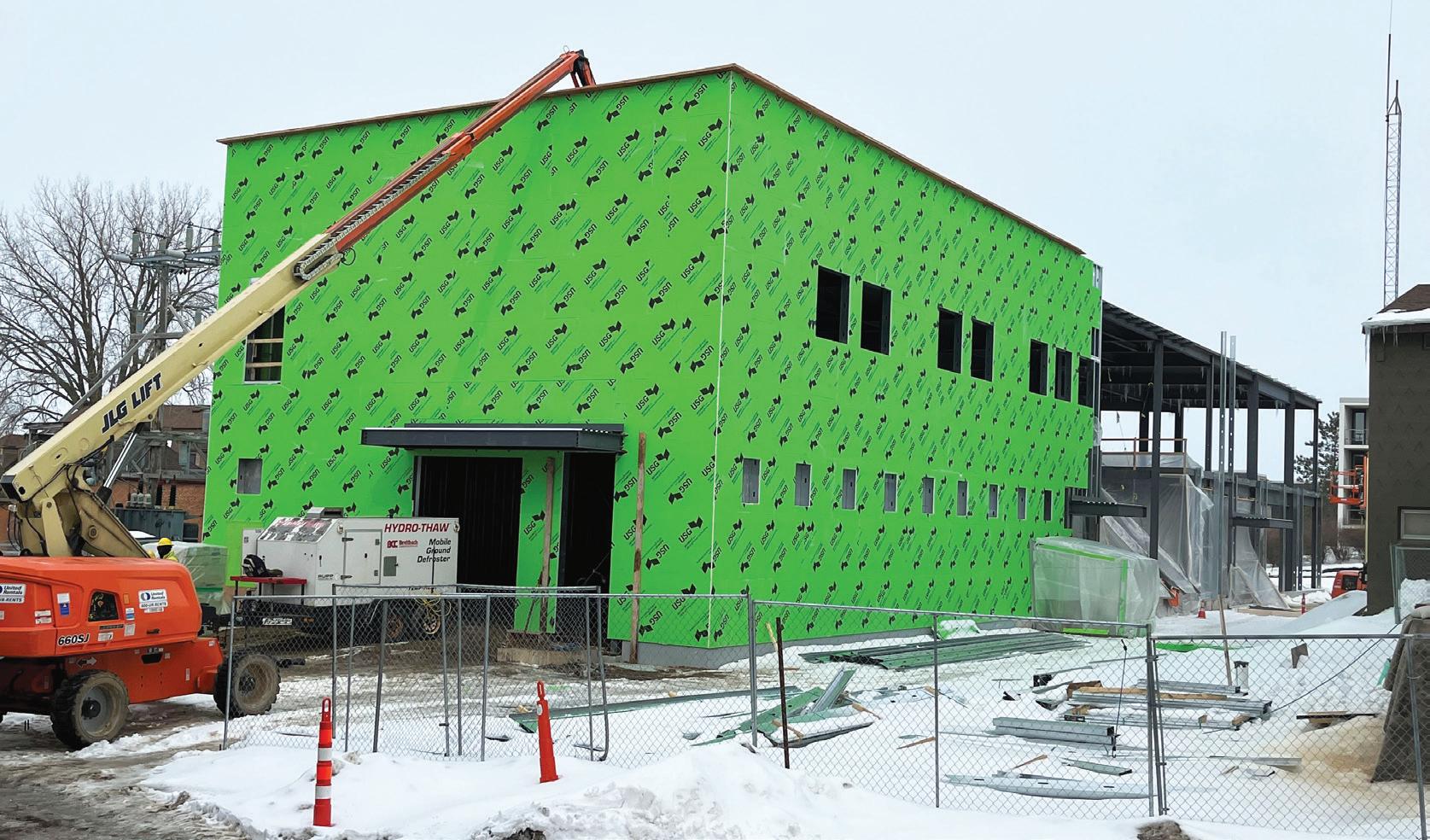
• For the past several years, visitors to the abbey and university church as well as those who join the community for worship online might have concluded that the monks’ commitment to the Benedictine value of silence had gone berserk. The aging sound
The monastic community and all the faithful of the Diocese of Saint Cloud rejoiced at the announcement on 15 December that Pope Francis had appointed Father Patrick Neary, C.S.C., as the tenth bishop of Saint Cloud, succeeding the beloved Bishop Donald Kettler who has shepherded the diocese with grace and wisdom since 2013. Abbot John Klassen led a delegation of monks to St. Mary’s Cathedral in Saint Cloud for the episcopal ordination of Bishop Neary on 14 February.
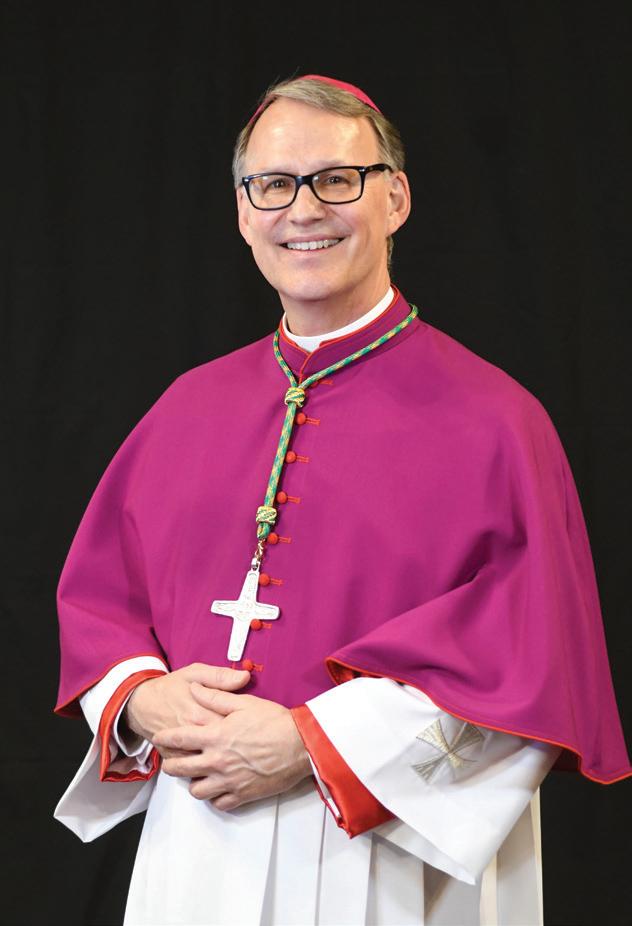
Bishop Neary completed undergraduate studies at the University of Notre Dame, including a semester at Anahuac University in Mexico City, where he learned Spanish. He professed perpetual vows with the Congregation of Holy Cross in 1990 and was ordained a priest in 1991. He has served in a variety of positions at Notre Dame, including in the campus ministry office, primarily ministering to Latinx students, and as rector at Moreau Seminary. He also served the Church in Africa at the congregation’s seminary in Nairobi, Kenya, and as district superior of Holy Cross in East Africa.
system was routinely sabotaging the community’s liturgies—with sound volume ranging from wildly overpowering to dead silence—and interfering with the monastery’s livestream programming. With the assistance of the aptly named firm Kode Blue Audio, the sound system is being upgraded, aiming to restore full aural functionality by Easter so that “anyone who has ears to hear ought to hear” (Mark 4:23).
• Saint John’s sweet season is going on a diet. The monastic community, which has been collecting sap and making maple syrup since the 1940s, plans to produce maple syrup every other year. During non-
production years (such as 2023), the staff of Saint John’s Outdoor University will tap a few trees for educational purposes but will not host the public Maple Syrup Festival. Semisweet!
All you winds, bless the Lord; Frost and chill, bless the Lord; Dew and rain, bless the Lord; Praise and exalt God above all forever.
Daniel 3:65,68–69
Spring 2023 Abbey Banner 34 35
MnDOT
Diocese of Saint Cloud Lew Grobe, O.S.B.
Plow on, Clearopathtra!
The sheathing of the new woodworking/organ building was the only green in Collegeville for the feast of Saint Patrick.
Excerpted from Confrere, newsletter of Saint John’s Abbey:
26 February 1973
After a report on the needs for health care facilities for the retired and ill monks by Brother Gerard Wojchowski and an inspiring discussion by concerned confreres, capitulars voted to proceed with the drawing up of plans for health care services and for additional housing.
After a symphonic silence at Saint John’s for the past several years, a Saint John’s and Saint Benedict’s Symphony Orchestra has been organized. Confreres Arnold Dittberner, Jerome Coller, and William Skudlarek are members of the orchestra, under the direction of Mr. Jerome Luedders of the Saint Benedict’s faculty. Before its discontinuance some years ago, the Saint John’s Symphony Orchestra was reputed to be the third oldest symphony orchestra in the United States.
Brother James Linn is carrying on work begun by Father James Hansen in 1894, germinating wild seeds collected within a 30mile radius of Saint John’s. He decided that the best way to provide a natural research situation for future botany students would be to replant the Saint John’s swamps with indigenous plants that have been destroyed. “There is the special joy for me in perpetuating a living laboratory,” Brother James remarked. “I can perpetuate life rather than press it in a collection album.”
28 April 1973
Brother James Tembrock, abbey weathermonk and ecologist, reports that March 1973 was the second warmest March ever recorded at Collegeville, the second cloudiest, and the second wettest in the last twenty years. Not since 1910, the year that 81° was reached in March and the Sagatagan opened on its earliest date of March 23, has that month been so warm. By means of a graph, Brother James showed that since 1956 we have been experiencing a period of extensive cloudiness unprecedented in our weather history. Brother James noted: “If this cloudiness continues, there will soon begin to arise great suspicion that some new factor is making a major influence upon the weather, and that new factor may very well be increasing air pollution.”
29 May 1973
His Holiness Abuna Theophilos, Patriarch of the Ethiopian Orthodox Church, visited Saint John’s as a guest of the [Hill Museum & Manuscript Library].
Patriarch Theophilos is the first reigning patriarch of the ancient
State Church of Ethiopia to visit the Western Hemisphere. The patriarch has agreed to sponsor the microfilming of manuscripts in Ethiopian churches and monasteries and thus to reveal and share some of the treasures of a Church whose history covers more than 1600 years.
After an announcement that Saint Benedict’s High School, Saint Joseph, Minnesota, would close this year, [Saint John’s administrators undertook a study] to determine the feasibility of enrolling young women at Saint John’s Preparatory School. The monastic chapter accepted a proposal that the prep school admit girls as day students beginning in the fall of 1973.
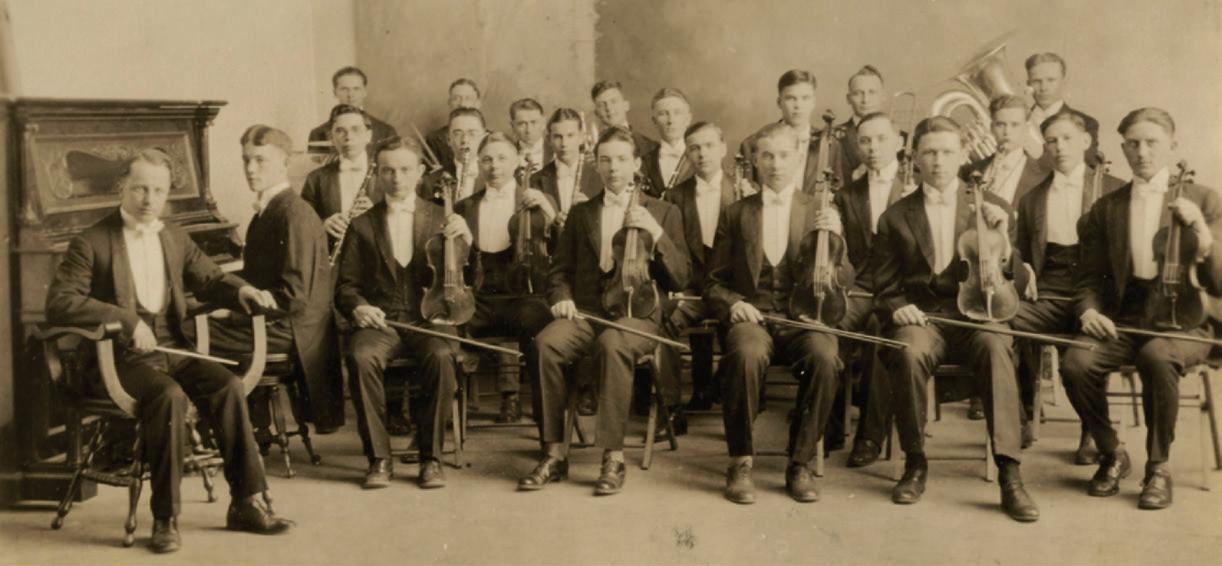
The April 26 edition of the Sauk Centre Herald gave a pictorial report of the extensive damage done to the old dairy barn at the former Saint Alexius Priory near West Union. Heavy winds practically dismantled the 90-year-old structure except for the sturdy lower section where a herd of 69 milk cows was left uninjured.
Flake out!
Ælred Senna, O.S.B.
Irecently realized that I had never written about one of my most favorite things to make—flaky pie pastry! It’s quite simple to do, but it helps to know how it should look along the way—so I’m including several photos, along with descriptions in the recipe below. The key is not to overwork the dough at any step. Fear not! It’s just some pie dough.
Brother Ælred Senna, O.S.B., is publisher of Give Us This Day and abbey refectorian.
1. Combine the flour, sugar, and salt in a mixing bowl. Use a pastry blender to cut the butter into the flour until you have a mostly crumbly mixture with some pea-sized pieces of butter still visible.
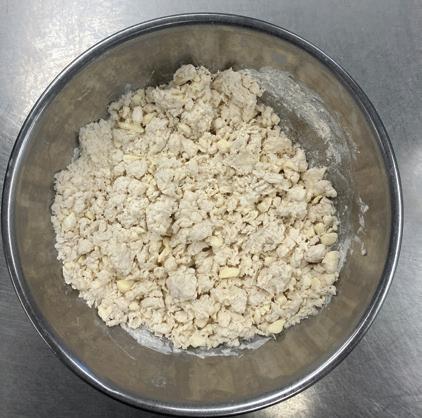

2. Add about 4 ounces of cold water, stirring it into the mixture well with a fork. Add the last bit of water and stir until it is a shaggy dough.
Flaky Pie Pastry
(Yields 2 pie crusts)
• 2½ cups flour
• 2 tablespoons sugar
• ½ teaspoon salt
• 1 cup cold butter, cut into small chunks

• 5 oz. ice-cold water (ice the water, then remove the ice just before using; measure carefully)
3. Use your hands to squeeze and press the dough until you can bring it together as a ball. You should be able to see bits of butter in the dough ball.
Note: If the butter begins to melt into the flour, chill the dough and your hands a bit before continuing.
4. Divide the dough in two; wrap each piece in plastic film. If you will make a round pie crust, shape it into a disk. If cutting strips or rectangles, make a square or rectangle. (You should still be able to see the butter in the dough.) Chill the dough for 45 minutes to an hour before rolling. The dough can be made ahead of time and refrigerated for a couple of days.
5. On a well-floured surface, with a floured rolling pin, roll dough to about 1/8” thickness. Try to achieve an even thickness all over. (There will still be streaks of butter throughout the dough.)


6. Line the pie tin, cut out mini-crusts, or whatever the recipe calls for. For hand pies (see photo), brush the crust with an egg wash and add some coarse sparkling sugar.
Bake at 425° F for 20 to 25 minutes for hand pies. Bake for 25 to 35 minutes for a full-size pie, with or without a top crust.

Spring 2023 Abbey Banner 36 37 Monks in the Kitchen Fifty Years Ago
University archives
Saint John’s University Orchestra, ca. 1925
Photos: Ælred Senna, O.S.B.
Please join the monastic community in prayerful remembrance of our deceased family members and friends:

Jason L. Anderson
Margaret I. Annas
Silas “Si-Guy” Baustert
Pope Benedict XVI
John W. Beuning
Vernon Joseph Bolduc
Clarence Joseph “CJ” Bruess
Rita R. Buckley
Thomas Edward Burnett Sr.
Lee Byeong-yeol
Cornelius P. Chang, O.S.B.
Jack Chaphalkar
Gabriel Chávez de la Mora, O.S.B.
Patricia Ann DeVetter
George Edward DeVinny
Damian Dietlein, O.S.B.
David F. “Dave” Durenberger
Norma Jean Edie, O.S.B.
Jonathan Fischer, O.S.B.
Urban J. Frank
Paul E. Giinthir
RoseMary Goossens
Francella Gust, O.S.B.
Agnes Hackenmueller, O.S.C.
David Leon Hagen
Wisdom of the Weak
Jeffrey John “Jeff” Hansen
Elizabeth M. “Betty” Harthman
Angelo Haspert, O.S.B.
Thomas “Tom” Hilgers
James K. “Jim” Keane
Daniel Kelly Jr.
David Owen Kieft
Gary C. Klein
Patricia “Pat” Knuth
Marlene Koellner
Charles Kubesh
Lucille M. Kuhl
Carleen A. Launderville
Beatus Timothy Lucey, O.S.B.
S. Merle Maerz, O.S.B.
Antoinette “Toni” Maggio
Gregory M. “Greg” Marincel
Peter L. Matter
Helen M. Maurer
Patrick McCool, O.S.B.
Patrick “Chuck” McDonald
Sidney W. “Sid” McGee
Deacon Michael Allen Medley
Donald Alexandre “Don” Molloy
Leonard A. “Len” Mrachek
Matthew Emmet Nolan
Robert John “Bob” Obermiller
Harold C. (Peregrine) Olson
Danial Peterson
Jean Pierre Roussel
Danielle Lee Sagissor
Sylverius Anthony “Syl” Sand
Abbot Christopher Schwartz, O.S.B.
Sarah Smedman, O.S.B.
Deacon Mark Stenger
Howard P. Studivant, O.S.B.
Lorraine C. Symalla
Nancy Tess
Patricia Ann “Patty” Thurk
David J. Volkmuth
Don Vossen
Jeffery John “Jeff” Wachlarowicz
Thomas M. “Tom” Wachlarowicz
Roger A. Wagner
Loretta Mary Wippler
Marie T. Young
Janet “Jan” Zilka
Serena Salomea Zilka, C.S.J.
William Leo “Bill” Zilka
Precious in the eyes of the LORD is the death of God’s faithful ones. Psalm 116:15
A Monk’s Chronicle
Father Eric Hollas, O.S.B., offers spiritual insights and glimpses into the life of the Benedictine community at Saint John’s Abbey in a weekly blog, A Monk’s Chronicle. Visit his blog at: monkschronicle.wordpress.com.
Father Don’s Daily Reflection
Father Don Talafous, O.S.B., prepares daily reflections on Scripture and living the life of a Christian that are available on the abbey’s website at: saintjohnsabbey.org/reflection/.
Timothy Backous, O.S.B.
While a graduate student, I spent so much time writing and researching that my body started to ache. To remedy the situation, I decided to rise each day before dawn and walk to a nearby park. This turned out to be a life-changing decision. Not only did it save my body from atrophy, but it also touched my soul in unexpected ways.
One morning as I passed by a building being renovated, I noticed a pile of debris and chose to walk over it. To my astonishment, the pile of garbage moved under my feet! Looking back, I saw a hand, then an arm, and finally the head of a young man who had been asleep there. I asked if he were O.K.—which now seems like the dumbest question to ask someone asleep in a garbage pile. The gentleman replied that he was fine and gave me a thumbs up. I asked if he were hurt, and he said no. I wished him well and walked on, still rattled by the event.
As I walked, I began arguing with myself about taking the man back to our residence, feeding him, maybe offering him some money and provisions for the day. But I wondered: What if he is dangerous? What if I’m taking an unstable person into our home? What if he had a weapon or was violent? What if . . ., what if . . ., what if! All these possibilities paled in comparison to the Christian duty I felt to help this guy. I turned back, intent on doing whatever I could. When I returned to the debris pile, he was gone. I searched but saw no trace of the man, and I realized I had lost my chance to help him. I went home, dejected, kicking myself for my hesitation. I recall this experience each time I read scriptural passages about helping the poor and destitute.
Saint Paul writes that God chose the foolish to shame the wise; God chose the weak to shame the strong; God chose the lowly and despised, those who count for nothing, to reduce to nothing those who are something (1 Corinthians 1:27–28). I don’t know how wise or strong I am, but I definitely had the edge on this guy—I was getting an education, living in a beautiful house with bountiful meals and a hot shower, and so much more. My hesitation to help this person shamed and reduced me to nothing. Yes, God chose the foolish to shame the wise theology student!
That encounter taught me more than the books I was researching. I learned that compassion and sacrifice are expected of us—even in unexpected ways. If we call ourselves Christians, we can’t ignore the words and actions of Jesus whose message, while not complicated, is revolutionary.
Compassion and sacrifice are expected of us.
39 38
In Memoriam
www.saintjohnsabbey.org
Abbey Banner
31
8–14
We invite you to participate in a silent, six-day retreat at the abbey guesthouse during which you can cast into the deep waters of your faith.
For additional information or to register, visit: abbeyguesthouse.org; contact the Spiritual Life Office at 320.363.3929; or email us at: spirlife@osb.org.
do not reduce in size (size or place between 100% and greater) use alternative logo for smaller size Nonprofit Organization U. S. Postage PAID Saint Cloud, MN Permit No. 2650
Banner Magazine
John’s Abbey
Box
U.S.A.
Abbey
Saint
P.O.
2015 Collegeville, MN 56321–2015
Spring 2023 Volume 23, Number 1
Directed Retreat
CHANGE SERVICE REQUESTED
Six-Day
June
2023
4 This Issue Robin Pierzina, O.S.B. 5 Earthquake Moments Abbot John Klassen, O.S.B. 6 The Shroud of Turin Cyprian Weaver, O.S.B. 10 Who Rises? Martin F. Connell 13 Were You There? Brutus at Calvary The News that Can’t Be Told Kilian McDonnell, O.S.B. 14 Forest Vernal Ponds John Geissler 17 Sacred Ground 18 Benedictine Volunteer Corps Joseph Stangler Joseph Luedke
The Weber Brothers Aaron Raverty, O.S.B.
Memorable Insights Patrick Henry
Rule of Benedict: Who Elects the Abbot? Eric Hollas, O.S.B. 28 Meet a Monk: Nickolas Kleespie Timothy Backous, O.S.B.
Prayers of the Faithful
22
26
27
30
Obituary: Jonathan Fischer
Cloister Light
Abbey Chronicle Robin Pierzina, O.S.B.
Fifty Years Ago
Monks in the Kitchen: Flake out! Ælred Senna, O.S.B.
In Memoriam
Wisdom of the Weak Timothy Backous, O.S.B.
32
33
36
37
38
39




























 Joseph Luedke, Benedictine Volunteer, 2022–2023
Photos: Benedictine Volunteer Corps archives
Zechariah, Luke 1:78–79
Killer Cop by Juma
Heartcatcher by Nicolas Maina
Diving Whale by Juma
Desert Manyattas by Yusuf Mirembe
Joseph Luedke, Benedictine Volunteer, 2022–2023
Photos: Benedictine Volunteer Corps archives
Zechariah, Luke 1:78–79
Killer Cop by Juma
Heartcatcher by Nicolas Maina
Diving Whale by Juma
Desert Manyattas by Yusuf Mirembe





























